THE HUNT MUSEUM, LIMERICK, IRELAND, DODECAHEDRON

Karen Wilson, Head of Collections and Interpretation at the Hunt Museum, Limerick, Ireland wrote the following concerning the dimensions of their ancient dodecahedron artifact:

The above PURPLE text is taken from the letter-description sent to this researcher, related to each face hole-size (in mm) for the dodecahedron artifact held in the collection of the Hunt Museum, Limerick, Ireland.
The BLACK text has been added by this researcher to convert millimeters to inches for dodecahedron face-holes 1 to 6.
The. RED text has been added by this researcher to convert millimeters to inches for dodecahedron face-holes 7 to 12.
Each face-hole is described above as either a circle with a singular diameter or an ellipse with two diameters, 90-degrees opposed.
Along with the Hunt Museum hole diameters in millimeters (converted to inches by this researcher) are listed some very close-proximity code-bearing values used by the ancient Druids for calculations in cyclic-astronomy, navigation, the Sabbatical lunisolar calendar and the Lunar Nutation cycle, etc. Those same numbers (in strings or progressions) were used in all weights, measures and volume standards of the great civilisations of antiquity, extending to recent centuries.
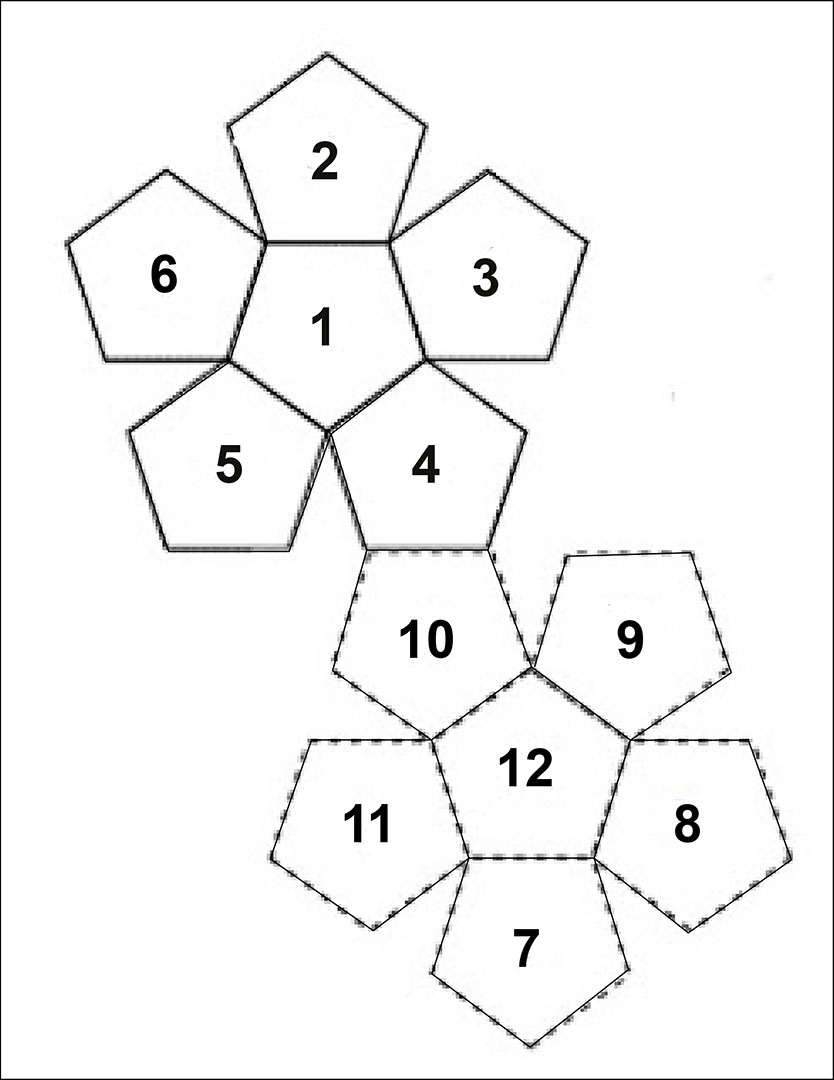
The numbering sequence for the face-holes on the Hunt Museum dodecahedron, starting from the largest hole and viewing through it to its opposite.
THE ANCIENT MEASUREMENT STANDARD USED BY THE DRUIDS & THEIR FOREBEARS ... EXTENDING FROM THE MEGALITHIC-NEOLITHIC EPOCH & EARLIER.
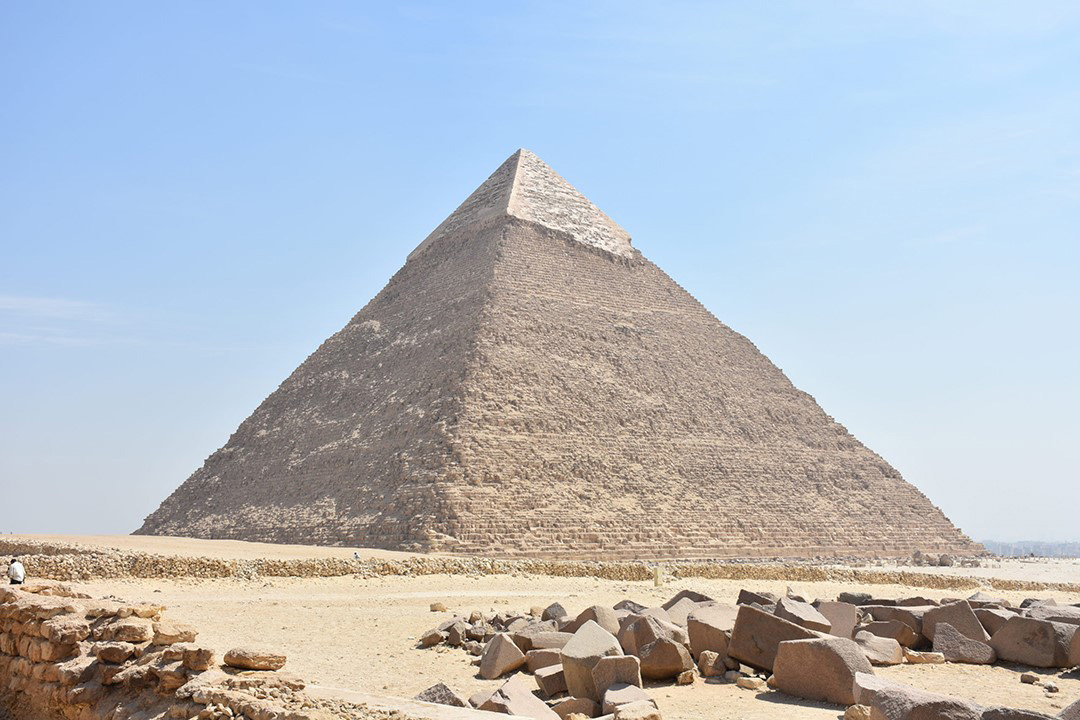
The Great Pyramid of Egypt and other pyramids of the Gizeh Plateau acted as a Bureau of Standards from which the civilisations of antiquity, extending to modern eras, based their Weights, Measures and Volume Standards.
It was obviously realised in remote antiquity that if one is to enjoy the abundance and benefits of "CIVILISATION", then there is a body of essential, prerequisite, scientific knowledge that must first be gained. Once a civilisation has that knowledge, then its “wise-ones” (the few set aside to bless the many) must religiously preserve it and hand it on intact to each ensuing generation. Failure to do so means that one has just cursed one's children and, to whatever degree the knowledge is lost, so too is lost one's grasp on civilisation.
One truth that will come as a surprise to some is that the "so-called" British Standard "inch" and "foot" are very ancient and all of the cubits or feet of the great civilisations of recorded history in the Mediterranean-Continental European-British Isles theatres were based upon the self-same inch. Moreover, all of the measurement standards of one civilisation were either the same, or precise ratio expressions to the standards of the surrounding confederation of cousin civilisations.
Everyone used the same integrated parcel of factorable numbers to describe their cyclic or astronomical sciences and the way they eternally recorded those sciences was by incorporating those special numbers, by code-bearing lengths and angles, into public buildings/ edifices or portable memory devices like the Druidic dodecahedron.
Even much earlier in history, extending from the Neolithic Age, the sprawling marker-mound complexes and multitude of standing-stone circles were eternal repositories of the special numbers, (extractible by length and angle calculations from a hubstone to an outlier stone). Added to that, specialist teachers carried mnemonic devices into which the numbers were encoded and this, as it turns out, included the carefully fabricated “Volva staffs” of the traveling, wise women of Europe or the Druidic dodecahedra memory-devices.
In the 19th century J Ralston Skinner, American archaeologist, did extensive investigations and measurements of Ohio's expansive, ancient, geometric earth-embankments. Skinner's conclusion was that the mound builders of the Ohio Valley had positively used the increment that today is known as the British standard inch in the design and construction of the geometric complexes. See: Skinner, J. Ralston. "Identification of the British Inch as the Unit of Measure of the Mounds of the Ohio Valley Builders." Journal of the Cincinnati Society of Natural History Vol. 9 (July 1886), pp. 51-63.
This journal could formerly be accessed online by going to: Cincinnati Historical Society Digital Journals.
Likewise, Sir William Flinders Petrie deduced that the "inch" used on the Great Pyramid was within 1/100th of an inch (visually undetectable) to the British Imperial Inch. Other researchers had come to similar conclusions, one of which (Taylor) put the Pyramid Inch to within 1/1000th of the Imperial Inch.
The finalised, big numbers that had to be remembered by ancient civilised society might look reasonably unfriendly. This is because nature has a bad habit of running cycles to its own schedule, without consulting accountants. A solar year is 365.2422-days and a lunar year is 354.3643519-days. The lunar nutation cycle, where the Moon goes to a position called major standstill, returns to minor standstill, then returns to major standstill again, takes 6798.36-days or 18.61329277 solar years. The Earth is 24902.44523-miles in equatorial circumference. The polar circumference is 24816.55084-miles. The cycle of the Precession of the Equinoxes takes 25776-years to complete.
So, with these cumbersome, non-factorable numbers to contend with, how did ancient scientists turn this chaotic set of difficult values into an ordered, integrated and functional mathematical system?
- The solar year can be called 365 & 1/4-days, which is a nice rounded number equating to 8766 hours.
- The lunar year can be called 354 & 3/8th-days, which is 8505 hours.
- If a calendar is produced that runs for 7 solar years, then that equates to 2556 & 3/4th-days.
- If the lunar period within that calendar runs for 7 & 1/5th lunar years (one tenth of 72-years), then that equates to 2551 & 1/2-days.
- If a measurement rule is produced, based upon 5 & 1/4 feet, then 487 X 5 & 1/4 = 2556 & 3/4 feet/ days.
- The same measurement rule can be used for the Moon and 486 X 5 & 1/4 = 2551 & 1/2 feet/ days.
- If an auspicious mistletoe culling ceremony is performed on the 6th day after the calendar commences at the Summer Solstice, then the solar and lunar cycles can end on the same day 7 solar years later.
- If the world is described as 12 X 12 X 12 X 12 X 1 & 1/5th-miles (note: 1 & 1/5th is a tenth of 12), then that's 24883 & 1/5th-miles...only 18.8 miles short of the true equatorial circumference.
- If one wishes to navigate using a "6&7" series of numbers, those miles can be 5250' each.
- If one wishes to navigate using an "11" series of numbers, those miles can be 5280' each (for a world with a circumference of 24750-miles).
A wonderful little window of opportunity arises when a straight-line diameter, using an "11" number is converted to a "6" based circle using PI @ 314 & 2/11th ÷ 100 (1728/550th). Therefore 550 X this rendition of PI = 1728, which is fluidly divisible by 360°.
A wonderful little window of opportunity arises when a straight-line diameter, using a "6&7" number is converted to an "11" based circle, using PI @ 22/7. Therefore 525 X 22/7ths = 1650, which is divisible by 330, 660 or 360°.
A wonderful little window of opportunity arises when 1/7th of a 360° circle (51 & 3/7ths°) is multiplied by 1.75 = 90. A 630° compass will work very well using "7" series values.
If the cycle of the Precession of the Equinoxes is described as 25920-years, then that's 72 X 360.
If the lunar nutation cycle is described as 6804-days, then that's 19 & 1/5th lunar years, which is nicely divisible by "6&7".
On the basis of these "big" numbers, which had been "factored" to be in very close tolerance to the true size of the Earth or duration of cycles, the ancient civilisations then produced their "Weights, Measures & Volume" standards in direct compliance to the highly factorable numbers generated.
Therefore:
What (much later) became known as a "Greek" foot has an overall length of 12 & 3/5ths British standard inches (one tenth of 126"). A Greek foot is simply half of an Assyrian cubit or a tenth of a Hebrew Reed (10 & 1/2 British standard feet). Babylonian-Sumerian or Egyptian standards, as well as ancient Swedish, Germanic or many others preceding the fledgling Greek & Roman civilisations,comply to this same integrated system. All are in direct ratio to the standards of their cousin nations or more distant forebears of remote antiquity.
The very difficult-to-make, cast-metal dodecahedron objects, carried by the Druids, were, simply, “memory-devices” for recall of special numbers, related to astronomical cycles, navigation, the lunisolar calendar and predictions concerning changing weather patterns to be expected within the Lunar Nutation cycle (6804-days). This special set of scientific numbers were also used in customary weights, measures & volumes, essential for market-place transactions and public assurances that volumes paid for were true?
In order to identify what the Druid / savants would need to encode, by measurement, within dodecahedra mnemonic devices, we have to know the specific number strings or progressions they were using.
As it turns out, this should be less of a mystery than most people realise, as the highly-developed metrology systems of the great civilisations living, from remote antiquity, around the Mediterranean Sea Basin, across the vastness of Continental Europe, the British Isles and elsewhere are reasonably well-known and well-documented ... although, through neglect and declining knowledge over the past thousand years, many standards “drifted” slightly off the mark resulting in the very significant, original numbers being only half- remembered.
The old measures, instead of being corrected to the original core values, were then unceremoniously dumped out the door with the introduction of metrification and the ages-old sciences, encoded by numbers, were lost from memory or obscured.
Julius Caesar was an avid historian and writer who lived contemporaneously with the Druids of Britain and Continental Europe. He recorded the following observation concerning what the Druids taught in their open-air universities:
"The magnitude of the Earth and its divisions"... or ... "astronomy, mathematics, geometry, medicine, jurisprudence, poetry and oratory were all proposed and taught-natural philosophy and astronomy with severe exactitude". (See: De Bello Gallico, VII, 15, 16.. See also: Strabo I IV, page 197. Caesars Comm. Lib V. Sueotonius, V Calegula. E. Campion, Accounts of Ireland, pg. 18.).
In assessing the 133 or so dodecahedra discovered so far, we can say with confidence that they were fabricated with "SEVERE EXACTITUDE".
IT'S ALL ABOUT THE NUMBERS.
In the following analysis, the Hunt Museum value for the centre hole of each face shall be used for scaling the face to its exact size. All scaling is done in AutoCAD in inches, as the modern inch is the precise equivalent of the "ïnch" used by the Druids, and their masters-of-the-craft forebears.This fact is supported by measurements of the large, Druidic bronze plaque found at Coligny, Ain France in 1897, dating to about 50 AD.
Its measurements (in feet and inches) were 4.86' in the length of its top converting to 58.32" ( 58 & 8/25ths); its inner width, frame-edge-to-frame edge, was 4.536' or 54.432" (54 & 54/125ths); its outer height was 2.953125' or 35.4375" (35 & 7/16ths) and its inner height, frame-edge- to-frame-edge was 2.64' or 31.68" (31 & 17/25ths).
As we proceed in our analysis of the Hunt Museum's dodecahedron it will be shown that the above number values recur within the dimensions of this artifact, albeit in decimal fractions of the British standard inch (which is not necessarily of British origin, but has a very ancient pedigree in ancient metrology standards). All numbers identified, with exception to PI (3.1416) and PHI (1.6180339) can also be rendered as simple fractions.
FACE 1

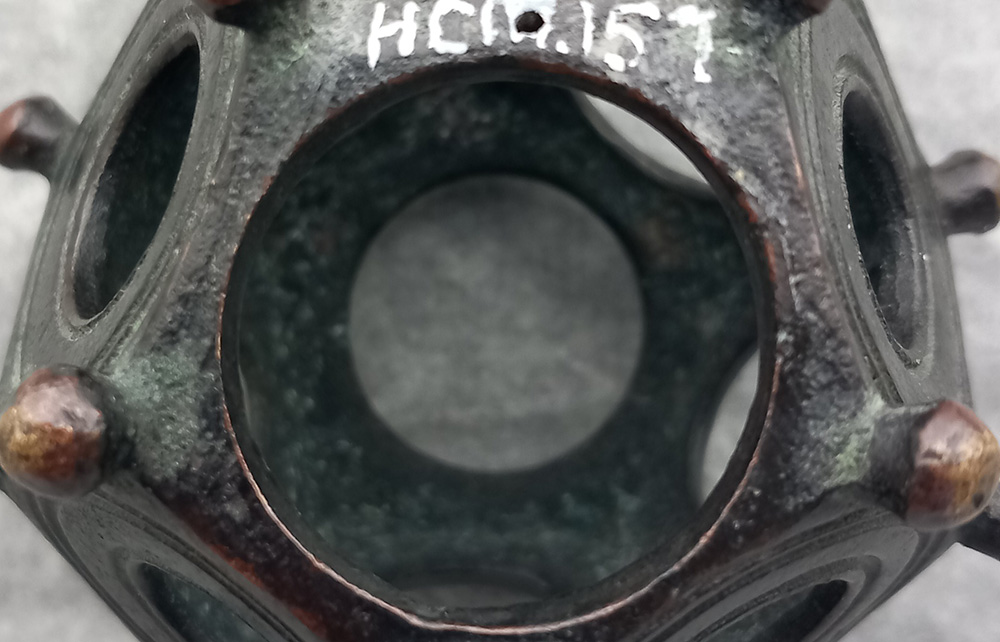
Magnified image of Hole 1.

The hole in Face 1 (the largest hole on a dodecahedron artifact) is considered to be the position where face numbering begins and was measured to be 24.2 mm (to a tolerance of .1 of a millimeter).
This converts to .9527559 of an inch, or just under .96" (24/25ths) by a meager shortfall of just 1/139th of an inch (visually undetectable by the human eye). The hole is very slightly elliptical and the circle shown above has an intended vertical height of .96", with a horizontal cross-measure of .945" (189/200ths). The sum of .945" is 1/129th of an inch short of .9527559" (again, undetectable to the eye).
A number string based upon 96 goes:
96, 192, 288, 384, 480, 576, 672, 768, 864, 960, 1056, 1152 ... 1344, 1440, 1536 ... 1728 ... 1920, 2016, 2112 ... 2304 ... 2592, 2688 ... 3456 ... 5184, 5280 ... 6048 ... 6720 ... 6912 ... 7776 ... 9072 ... 9504 ... 10080 ... 10368 ... 13824 ... 19008 ... 20736 ... 21600 ... 25920 ... 362880 ... 248832 ...130636800.
By using this string, based upon increases of the number 96, the Druidic savant could complete counts of miles in the equatorial circumference of the Earth, based upon the mile of 5250 feet (of 12-inches each ... which became known as the Greek mile by the golden age of the Greek empire ... 500 BCE).
There would be 2160 X 11.52-miles in the equatorial circumference; 777.6-miles would be 1/32nd of the circumference or 11.25° of arc; 69.12-miles would be 1° of arc.
The Druidic savant could also calculate seconds, minutes and degrees of arc, based upon 1-second being 100.8-feet of 12-inches each, 1-minute of arc being 6048-feet, 1° of arc being 362880-feet and the full circumference being 362880' X 360 = 130636800-feet or 12 X 12 X 12 X 12 X 1.2 Greek miles of 5250-feet of 12" (which equates to 5000 Greek feet of 12.6" each ... or 24883.2 such miles).
With this string the Druidic savant could also calculate intervals of time within the 25920-year long cycle of the Precession of the Equinoxes, with 2592-years being 1/10th of the cycle and 5184-years being 1/5th.
There would be 270 X 96-years in the cycle of Precession, with 1° of shift occurring over each 72-years, requiring 1-day of adjustment needed every 72-years to keep the day of the equinox true to the calendar count.
In this 25920-year count, the sun spends 2160-years in each of the 12 Houses of the Zodiac.
THE HORIZONTAL CROSS-MEASURE, 90° OPPOSED OF FACE 1.
As stated, the Face 1 hole is slightly elliptical, which is unsurprising, as Scottish engineer & antiquarian, Professor Alexander Thom (1894 - 1985), who studied hundreds of British Megalithic sites, found numerous examples of elliptical circles.
It stands to reason that this would occur, as circle sites, purpose-built to code-bearing length & breadth measurements, could carry two codes, 90° opposed, instead of just one. This attribute of elliptical holes in the faces of dodecahedra, or in the bas & raised relief concentric circles emanating out from the centre holes, is very commonly found.
As stated, the horizontal diameter of the hole in the above scaled photo is .945" (189/200ths), which is 1/129th of an inch shortfall on the recorded diameter supplied by the Hunt Museum personnel.
However, the numbers .945, 9.45, 94.5, or the whole number 945 would be very significant values to Druids encoding their cyclic-astronomical or navigational sciences in memorised number strings.
A number string based upon 94.5 goes:
94.5, 189, 283.5, 378, 472.5, 567... 756, 850.5, 945 ... 1036.8 ... 1134 ... 1417.5, 1512 ... 1701... 1890 ... 2073.6 ... 2268 ... 2551.5 ... 2835 ... 3024 ... 3402 ... 4536 ... 5103 ...6048 ... 6804 ... 7087.5 ... 9072 ... 11812.5 ... 13608 ... 35437.5 ... 362880 ... 130636800.
With this number string, the Druid reader of the mnemonic-device dodecahedron could identify the length system, built into the base dimensions of the Great Pyramid of Egypt, which related to the equatorial circumference of the Earth.
Numbers generated within the same string-progression also identified the base dimensions of the Khafre Pyramid of Egypt (a pyramid of the Moon) and how its length or perimeter values related to the lunar cycles, namely the lunar month & year, as well as the 6804-day lunar nutation cycle. Added to that, it identified the 3,4,5 triangle design-coding of the Khafre Pyramid's half base length, vertical height to the apex and hypotenuse face-slope length.
In the above lineup 189', 378', 567' and 756' represent 1/4h, 1/2, 3/4ths & the full length of the Great Pyramid. The sums of 1512', 2268' & 3024' represent 2, 3 and 4 side perimeter lengths around the base of the Great Pyramid. The sum of 2 full circumnavigations around the base equates to 6048' or 1-minute of arc in the Earth's equatorial circumference.
The sum of 362880'equates to 1-degree of the Earth's equatorial arc, with 130636800' being the entire circumference (362880' X 360-degrees).
Added to the above, 453.6' is the vertical height to the flat floor atop the Great Pyramid ... it was always a truncated pyramid and never observed to have a pointed capstone in all recorded history.
In the above string, 708.75' is the length of 1-side of the Khafre Pyramid, with 1417.5', 2126.25' & 2835' being 2, 3 and 4 side lengths. The Khafre Pyramid was designed to be 15/16ths the length of the Great Pyramid. Thus 756' ÷ 16 = 47.25' X 15 = 708.75'.
Also in this string is seen the number 1036.8 and its doubled value, 2073.6. So what do these generated values refer to?
There were 3 known Egyptian Royal Cubit rules:

The first, or shortest of these, was 20.61818182" (20 & 30909090/ 50000000ths) long (an example of which is in the Turin Museum collection).
A second, or mid-range of these, was 20.625" (20 & 5/8ths) long.
The existence of the 20.625" Royal Cubit is confirmed by the careful measurements of Sir William Flinders Petrie in the King's Chamber of the Great Pyramid. Petrie concluded that the room was built according to a cubit of 20.620 inches, plus or minus .005 of an inch. The upper scale of his estimate is, therefore, 20.625 inches (see The Pyramids and Temples of Gizeh, by Sir William Flinders Petrie).
The third Egyptian Royal Cubit, or longest, was 20.736" (20 & 92/125ths).
Sir William Flinders Petrie measured the coffer in the Great Chamber of the Khafre Pyramid and accurately determined it had an outer length of 103.68-inches (103 & 17/25ths). This value doubled = 207.36-inches (207 & 9/25ths). In other words, the coffer was 5 cubits long using a cubit of 20.736-inches or 1.728-feet. The same cubit was represented in the dimensions of paving slabs at the base of the Great Pyramid. One of several codes carried in the length value of the coffer was the speed at which the Earth rotates in miles per hour. Therefore: 24883.2-miles ÷ 24-hours = 1036.8 MPH.
Interestingly enough, the "Stirling Jug" of Scotland had a capacity of 103.68 cubic inches and this paralleled the Jerusalem Liquid Standard of the ancient Hebrews, wherein a "Cab" was 103.68-cubic inches.
Like the Hunt Museum dodecahedron or presumably all other hard-to-fabricate ancient dodecahedra metal objects, the Volva-Seidr staffs of the Scandinavian wise-women, the Bush Barrow Lozenge of Stonehenge, etc., the 3 known Egyptian Royal Cubits were mnemonic-devices. Their function was to encode the equatorial size of the Earth according to three slightly varying navigational systems, based upon multiplying the "inch" length of an individual cubit X 1200 and then reading the result in miles.
The final result for the 20.618" cubit (actually 20.61818182") X 1200 = 24,741.1818182- miles of 5280' or 24883.2-miles of 5250' (that's 12 X 12 X 12 X 12 X 1.2 Greek miles of 5250').
The final result for the 20.625" cubit X 1200 = 24750 miles of 5280' and this became the navigational method adopted in ancient England, Scotland and Teutonic-Scandinavian countries, as evidenced by their mnemonic-device artifacts or known mile standards. The ancient Scottish mile was 1-furlong (660') longer than the English-mile or 5940', but based upon the same "11" number family system for its increments.
At the same time, the ancient Irish mile was 6720' or 1440' longer than the English mile.
The final result for the 20.736"cubit X 1200 = 24883.2 miles of 5280' (English miles) and this is only 18.8-miles shortfall on the true equatorial circumference of the Earth.
In addition to the above, Face 1 has a bored depression or marker hole in the mid-section at the top. It seems obvious that this was put there for encoding another code-bearing measurement.

The yellow line, running from the centre of the marker hole at the top of the dodecahedron to the bottom rim of the large face hole, is 1.03125" (1 & 1/32nd) or half of 2.0625". It is thus for mnemonic recall of the 20.625" Egyptian Royal Cubit.
Due to the fact that the differences in length between the 20.61818182", the 20.625" & 20.736" (20 & 92/125ths) Egyptian Royal Cubits is so miniscule, this top marker hole would accommodate all of them at this 1/40th scale. The marker hole was obviously made for jogging the memory for recall of all 3 cubits and the navigational systems they encoded.
FACE 2
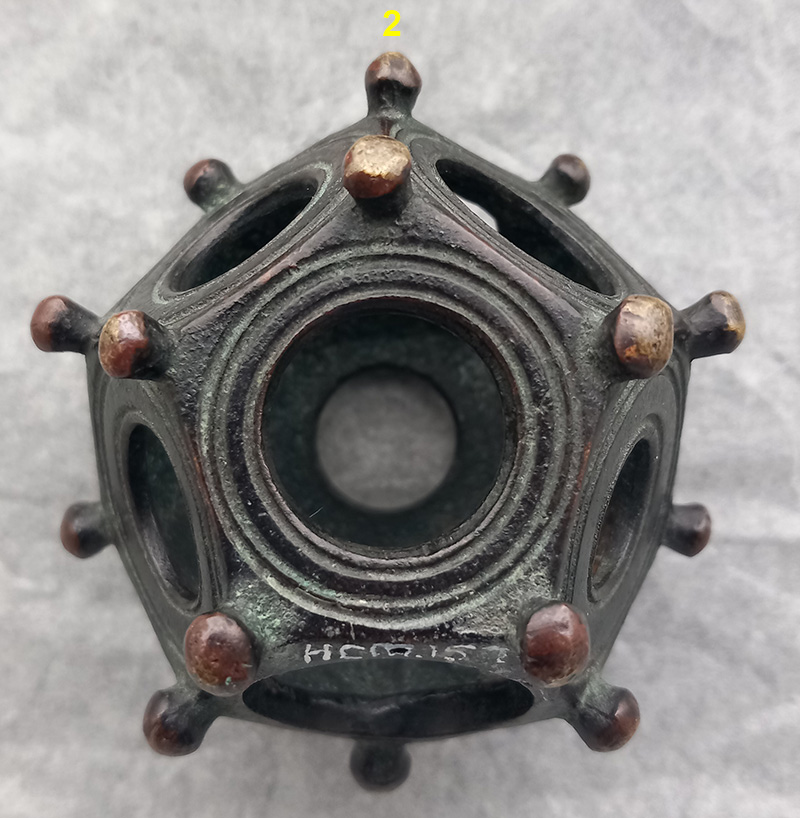
The Face 2 hole of the dodecahedron was measured to be 17.9 mm, which translates to .7047244". This is 1/250th of an inch (visually undetectable) short of the very significant number from the Druidic parcel of special scientific numbers, .70875" (567/800ths).
Alternatively, the number .7047244" measurement is only 1/1380th of an inch in excess of another number from the Druidic special parcel ... .704" (88/125ths) ... likewise a visually undetectable difference.
The hole diameter is .70875" (567/800ths) ... yellow and white circles blended together with the white one being the Hunt Museum measurement.
A number string based upon .70875 goes:
.70875, 1.4175, 2.12625, 2.835, 3.54375, 4.2525, 4.96125, 5.67 ... 354.375 ... 708.75 ... 756 ... 850.5 ... 1134 ... 1417.5 ... 1512 ... 1701 ... 2268 ... 2551.5 ... 2721.6 ... 2835 ... 3024 ... 3402 ... 34536 ... 5103 ... 6048 ... 6804 ... 9072 ... 130636800
This string is primarily about the lunar cycle codes that were built into the dimensions of the Khafre Pyramid of Egypt (a pyramid of the moon). As stated, its length (708.75') is 15/16ths the length of the Great Pyramid (756') and 708.75-days would be 2 lunar years of 354.375-days each... about 11-days shorter than the solar-year @ 365.25-days.
The string also provides the important milestone days for the 6804-day lunar Nutation cycle (i.e.) 850.5-days (1/8th of the cycle); 1701-days (1/4th); 3402-days (1/2); 5103-days (3/4ths); 6804 -days (a full cycle).
The string also provides Great Pyramid numbers (i.e.) 756, 1512, 3024, 6048, 9072, 362880, etc. These are 1,2,3, & 4 side lengths, as well as 6048 'being 1-minute of equatorial arc; the side length in inches (9072") and the number for 1° of equatorial arc, 362880'... for a world calculated (for navigational purposes) to be 130636800' in circumference, or 12 X 12 X 12 X 12 X 1.2-miles (or 5250' each) in circumference.

In the above string, 354.375-days (354 & 3/8ths) is the duration of the lunar year; 708.75' (708 & 3/4ths) is the length of the Khafre Pyramid; 1417.5' (1417 &1/2) is the length of 2-sides; 2126.25' (2126 & 1/4th) is 3 side lengths and 2835' is 4-sides.
The number string also provides all the essential interval values for the 6804-day lunar nutation cycle of 6804-days, with 850.5-days being 1/8th of the period; 1701-days is 1/4th of the period, 3402-days is 1/2, 5103-days is 3/4ths and 6804-days the full duration of the cycle.
Likewise, the number string continues all the way to 130636800, which in feet is the equatorial size of the Earth under the Great Pyramid's literal encoded navigational system of 756' per side or 9072". The circumference read as 130636800' is 12 X 12 X 12 X 12 X 1.2 Greek miles of 5250' (5000 Greek feet of 12.6"each) ... 24883.2-miles.

The Khafre Pyramid was also architecturally designed to represent two back-to-back 3-4-5 triangles, based upon lunar numbers. The half-length was 354.375' and 354.375-days is the duration of the lunar year (3 X 118.125-days or 4 lunar months of 29.53125-days (29 & 17/32nds) ... accurate to less than 1-minute per month. The pyramid's design height was 472.5' or 4 X 118.125 and the sloping faces were 590.625' each or 5 X 118.125'... in days = 16 & 20 lunar months respectively. The sum of 118.125 (118 & 1/8th) in days would be 4 lunar months of 29.53125-days (29 & 17/32nds).
For the Druidic astronomers, the .70875" encoding would probably be the most important or sought after value for this face-hole size.
However, the .704" (88/125ths) value goes:
.704, 1.408, 2.112, 2.816, 3.52 ... 6.336 ... 7.04 ... 10.56 ... 17.6 ... 19.008 ... 31.68 ... 35.2 ... 52.8 ... 88 ... 95.04 ... 101.376 ... 140.8 ... 158.4 ... 176 ... 5280 ... 11250 ... 130680000.
This was a 2nd navigational method that used the English mile of 5280'.
In the above line-up, an increase to 70.4' would be 1/75th of a mile of 5280'.
Beyond the face-hole diameter are a series of code-bearing concentric circles.
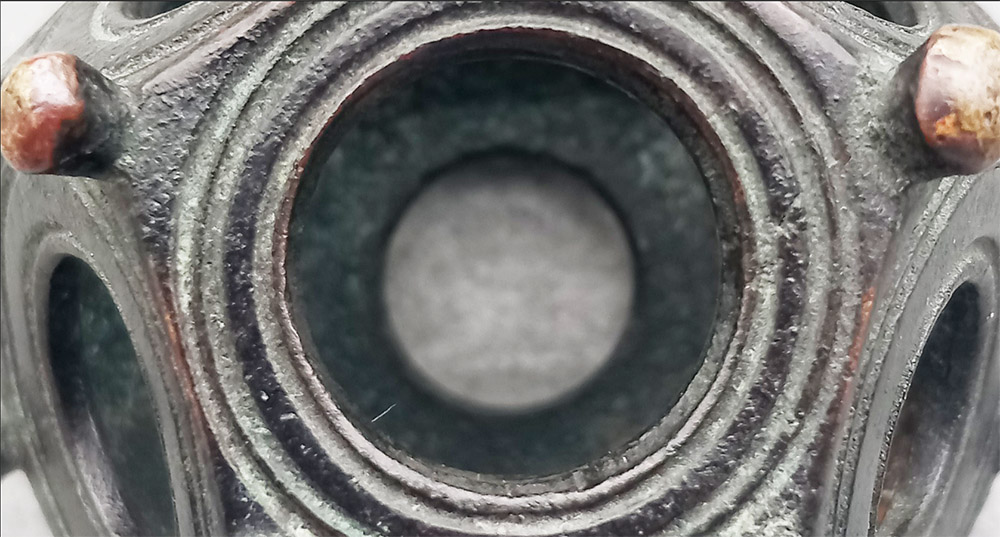
Magnified view of Face 2.
Of interest in the metal-casting is a half rim feature, like a waining crescent moon at its most extreme point before the new moon. It sits below the hole but wains thinner and thinner further upwards disappearing into the side of the hole. This design attribute in the casting is found on most faces of the Hunt Museum dodecahedron and was a way of cramming in an extra concentric circle or code-bearing diameter, measurable from the top edge of the hole to the outer edge of the half rim.

FIRST OUTER CONCENTRIC RING ... RED HALF RIM CIRCLE
(1). The half rim circle diameter is .729" (729/1000ths).
A mathematical progression based upon .729 goes:
.729, 1.458, 2.187, 2.916, 3.645, 4.374, 5.103, 5.832, 6.561, 7.29 ... 11.664 ... 25.515 ... 36.45 ... 46.656 ... 93.312 ... 4860 ...131220000.
This string, at a very late era, became the basis of the Roman system of metrology, with 7.29" being 1/8th of a Roman Pace of 58.32" or 5 Roman feet of 11.664 "each (11 & 83/125ths).
The Roman mile was 5000 Roman feet of 11.664" or 4860 imperial feet of 12". The Roman foot was found to be 11.664 inches by John Greaves, professor of geometry, who in 1639 went to Rome specifically to ascertain the length of an ancient Roman foot. Greaves located a monument of Roman architect, Stalius Asper and measured bas relief instruments used by him in the first century A. D. Greaves concluded, after careful investigation, that the Roman foot, 'contained 1944 such parts as the English foot contains 2000'. This means a Roman foot of 11.664 inches (11 & 83/125ths).
Whereas the value 11.664 was used in Weights, Measures (cubic) & Volumes (cubic), it is logical to assume a measurement of 11.66666" that was used in overland marching, making their Pace measurement to be 58.33333" for easy distance calculations.
One of the concepts of ancient metrology, which survived into mediaeval times, was that 75 Roman miles represented 1-degree of arc for the world. The Scandinavian system was, undoubtedly, adopted by the Romans and has its root origins within much older civilisations from remote antiquity.
The string is very convenient for calculating lunar cycle periods within the lunisolar Sabbatical Calendar, wherein 7-solar years (2556.75-days) was daily tracked on a parapegma plaque alongside 7.2 lunar years (2551.5-days). The discrepancy in the duration between the the 2 cycles was only 5.25-days, thus the lunar count was commenced on the 6th day after the solar count commenced at the summer solstice, thus terminating both periods on the same day 7 solar years later. This was the ancient lunisolar system, incorporated by the Druids on the Calendar of Coligny bronze plaque, for simultaneously monitoring both sun & moon daily progress through to the termination of the Sabbatical Year.
In the above string, the number 2551.5 is generated, which in days, is 7.2-lunar years of 354.375-days each (354 & 3/8ths). The string increases to 131220000 which, in Roman miles of 4860 imperial feet (12" or 5000 Roman feet), represented their navigational concept of the equatorial circumference of the Earth or 75-miles per degree of arc (1/360th).
However, based upon their overland marching system with a Pace of 58.33333" (5 Roman overland feet of 11.66666") the final equatorial circumference of the Earth was considered to be 131250000 imperial feet ... or 125000000 Greek feet of 12.6" or 135000000 Roman feet of 11.66666" or 67500000 Swedish Rydaholmsalm of 23.333333" or 27000 Roman miles or 3750 Swedish Mil or 25000 Greek miles.
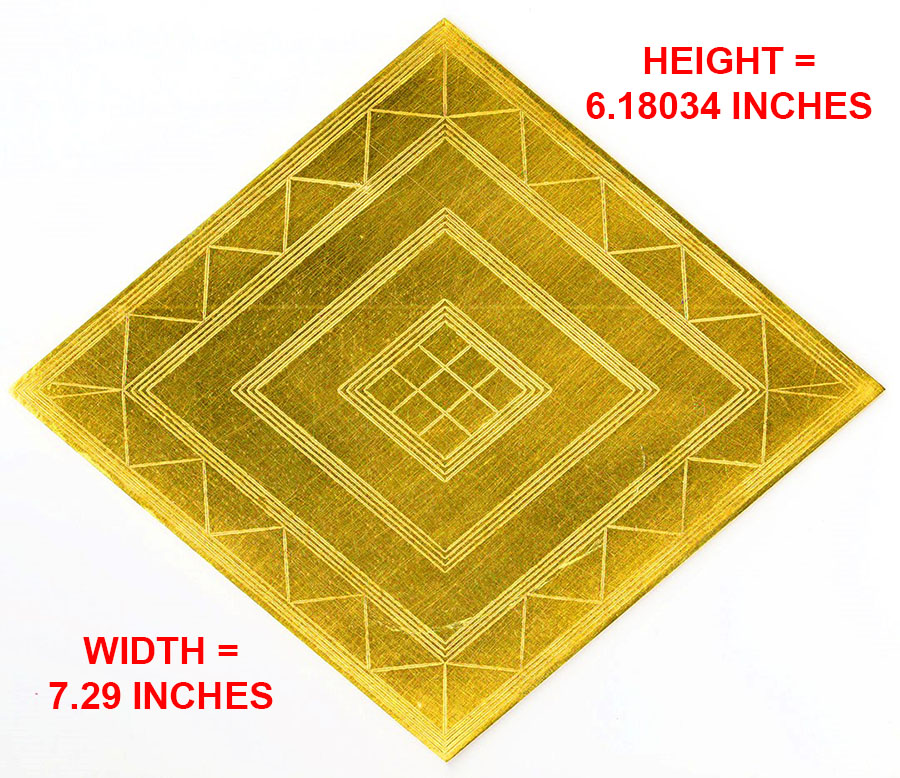
The Bush Barrow Lozenge artifact, exhumed from a grave beside Stonehenge and contemporary with the monument's usage. It has a diameter of 7.29-inches and a height of 6.18034-inches (the PHI reciprocal), based upon the value 10-inches ÷ 1.6180339 = 6.18034-inches. These encoded values were highly important to ancient civilisations, especially the 6.18034" PHI reciprocal, which was used for making perfect capacity, round grain tubs for marketplace use and "squaring the circle".
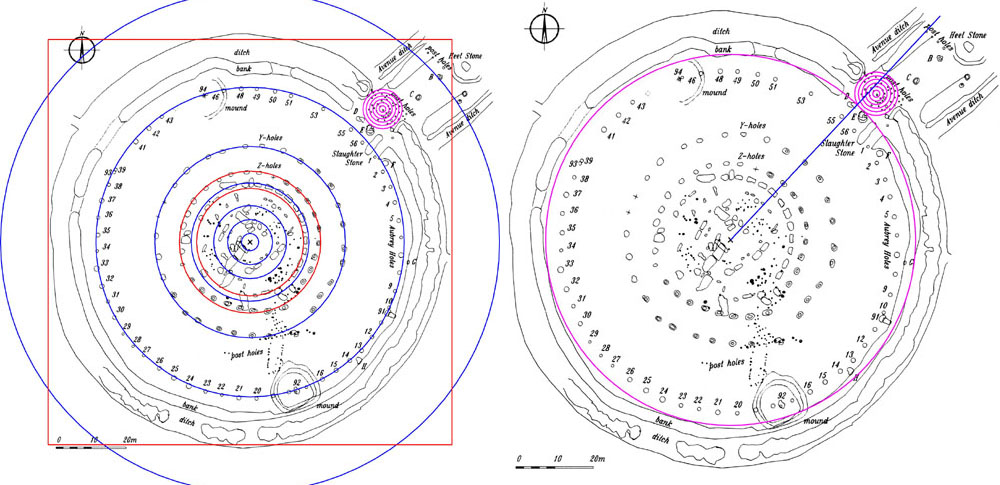
The image to the left shows how concentric circles within Stonehenge, marked by posts, stones or lintels are reducing by the PHI ratio of 1.6180339 to 1. An important marker-stone designated as B sits on the Avenue and, from the epicenter of Stonehenge, marks the outer rim of a blue circle with a diameter of 466.56'. This value occurs in the above string, based upon progressions of .729".
The outer blue circle has a red square overlaying it and the red square's diameter is based upon a 1/2 PHI (.80901695) reduction of the 466.56' diameter of the blue circle. Note how the red square perfectly encompasses the outer embankment of the Stonehenge site, with one side brushing the Heel Stone bank on the Avenue.
Note: The 466.56' diameter of the Avenue Circle, if rendered as miles, would be 1/53.333333rd (53 & 1/3rd) of the 24883.2 mile circumference of the Earth. The diameter in English feet of 12" would be 480 (of what later became) Roman feet (of 11.664") or 240 Swedish Rydaholmsalm ... also rendered as 11.666666"and 23.333333"respectively for overland distance measurements. The circumference achieved by a diameter of 466.66666' would equate to 1466.666666' using PI @ 22/7ths.
The diameter of the square is read as 378' for a shortfall of about 6". The half length of the Great Pyramid of Egypt is 378', indicating that the embankment diameter extremity was based upon a half length Great Pyramid.
The outer blue circle is reduced by PHI @ 1.6180339 and creates the Aubrey Circle with a coded diameter of 288', having an excess of about 2-inches. The number 288 is one of the most dynamic in the parcel of numbers of civilisation
Note: The 288' diameter of the Aubrey Circle equated to 166.6666666 (166 & 2/3rds) of the largest Egyptian Royal cubits @ 20.736" (1.728').
The Aubrey Circle is reduced by PHI @ 1.6180339 and creates the "Y" Holes Circle with a coded diameter of 178.2', with a shortfall of about 1". Again the 178.2 value is dynamic in ancient calculations, primarily used in navigation.
Note: The 178.2' diameter "Y" Holes Circle was coded to have a circumference of 559.872' (using PI @ 1728/550ths) and relate to the 24883.2-mile circumference of the Earth. The sum of 559.872 X 44 .444444 (44 & 7/16ths) = 24883.2. Also the circumference would equate to 324 of the largest Egyptian Royal Cubits @ 20.736" each.
The diameter could, however, be used as a near-value for mnemonic reference to 177.1875' (177 & 3/16ths) and relate to half a lunar year of 354.375-days.
The "Y" Holes Circle is reduced by PHI @ 1.6180339 and the result is the outer rim circuit of the Lintels on the Sarsen Circle, achieving a diameter or 110', with no error. This is encoding for the "11" family of numbers, much used in navigation by the English mile of 5280' or the Scottish mile of 5940'.
Note: The 110' diameter of the outer rim of the Sarsen Circle Lintels was coded to have a circumference of 345.6' (using PI @ 1728/550ths) and relate to the 24883.2-mile circumference of the Earth. The sum of 345.6 miles X 72 = 24883.2. Also the circumference in feet of 12" of the Sarsen Circle outer rim would equate to 200 of the largest Egyptian Royal Cubits @ 20.736" each.
The inner rim of the slightly elliptical Sarsen Circle Lintels was coded to be 100' in diameter, inferring that the circumference measured 3.1416' (or other close renditions of PI in use). At 90° opposed the cross-measure was 100.8' ,(indicating 1-second of the Earth's equatorial arc under the literal navigation system encoded into the base dimensions of the Great Pyramid).
The "Z" Holes Circle was not a PHI reduction, but coded to have a diameter of 132' (1/40th of an English mile or 1/45th of a Scottish mile).
Note: The 132' diameter "Z" Holes Circle was coded to have a circumference of 414.72' (using PI @ 1728/550ths) and relate to the 24883.2-mile circumference of the Earth. The sum of 414.72 X 60 = 24883.2. Also the circumference in feet would equate to 240 of the largest Egyptian Royal Cubits @ 20.736" each.
The above image to the right shows a magenta circle circumnavigating the inner rim of the embankment. It has a coded diameter indicating PI (3.1416), but incorporating other much-used renditions (22/7ths, 1728/550ths, 3.15, 3.125, etc.), anciently used in differing calculations with different number families to achieve a full number, code-bearing circumference, perfectly divisible by 360°.

In this picture the PHI reducing circles are shown as red and a perfect, two-dimensional, half-replica of the Great Pyramid's side profile is marked into the Stonehenge site.
It is glaringly apparent that Stonehenge was originally laid out using a half-scale, Great Pyramid template. The above picture is in perfect scale.
As with many other megalithic sites, some circles within Stonehenge are slightly elliptical. However, a 378-feet diameter circle (blue) encases the Stonehenge site virtually perfectly from outer-ditch-edge to outer-ditch-edge across the entire site, excluding only the more extended Avenue and Heel Stone @ 45°.
A stone marker designated as “H” in the above scaled plan delineates how a pyramid base line goes from 135-degrees to 315-degrees from the edge of the outer ditch, across the embankment, through the site’s epicenter, across the opposite embankment to finally resolve at the outer ditch edge 378-feet distant (half the length of the Great Pyramid).
At the same time, a line commences centrally at 90-degrees opposed to the pyramid baseline and runs for 240.5-feet @ 45-degrees to resolve against a post on the Avenue. En-route it dissects a Sarsen obelisk, as well as post positions on the Z-Holes Circle, Y-Holes Circle, brushes a post on the Aubrey Circle, runs between stones D & E, dissects a post row and resolves upon an end post near the Heel Stone.
On the southwestern side, the pyramid hypotenuse line brushes past recumbent marker stones, now tumbled off the top of the embankment to lie slightly off-line, brushes the Aubrey Circle, at the position of post 10's adjacent large stone marker, then proceeds to brush stone C before resolving on the end post that designates the apex.
The pyramid's slope angle of 51.84-degrees is offset accordingly and the apex is marked by a post on the Avenue. A centerline for the pyramid runs from the baseline to stone D, then along a line of 6 posts to its resolving position on the apex post.
SECOND OUTER CONCENTRIC RING ... RED CIRCLE
(2). The diameter is .80901695" (half of a PHI inch of 1.6180339").
As stated, there were diminishing PHI circles that defined the diameters of the Aubrey, Y Holes and Sarsen Circle of Stonehenge. These marked circles were, in the geometry of Stonehenge, overlaid in PHI reduced squares. The diameter of each square was .80901695 (half the PHI ratio) less in diameter that the circle that overlaid it.
The PHI ratio of 1: 1.6180339 was of immense importance to the maintenance of ordered, civilised, functioning societies, especially in the dispensing of standard grain quantities in round marketplace tubs, where "squaring-the-circle"ensured perfectly precise cubic capacities that were beyond dispute for both the vendor and purchaser
The area upon which the Great Pyramid sits is in a 1: 1.6180339 relationship to the face surface area of all four sides ... all the way to a nonexistent apex point at 481'. The Great Pyramid has always been truncated with a flat floor at a vertical height of 453.6'. However, the geometry of the pyramid allows for lines, coming up each diagonal face from the base to converge at an apex point, achieving 481'.
THIRD OUTER CONCENTRIC RING ... YELLOW CIRCLE
(3). The diameter is .88" (22/25ths)
A number string, based upon 88 goes:
88, 176, 264, 352, 440, 528, 616, 704, 792, 880 ... 1056 ... 1320 ... 1584 ... 1760 ... 2112, 2200... 2376 ... 2640 ... 3168 ... 3960 ... 4752 ... 5280 ... 6336 ... 6600 ... 7128 ... 7920 ... 11000 ... 33000 ... 59400 ... 130680000.
This string is navigational under the system that used the English mile of 5280' (or Scottish mile of 5940'); the league of 16500'; the diameter of the Earth set @ 7920-miles or the full equatorial circumference @ 130680000' (24750-miles).
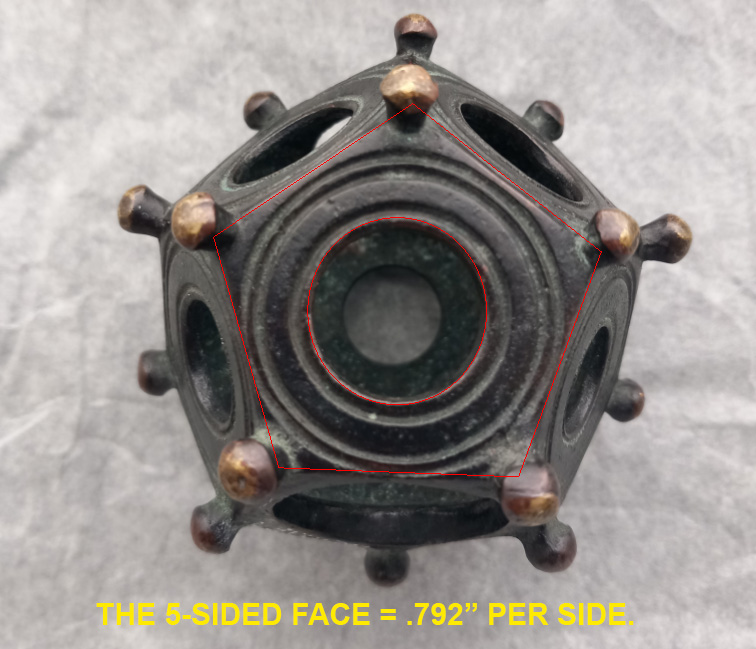
Although small misalignments occur within the face castings, the 5-sided perimeter was intended to encode lengths of .792" per side. This is in homage to the 7920-mile diameter of the Earth ... X PI @ 3.125 = 24750-miles.
FOURTH OUTER CONCENTRIC RING ... YELLOW CIRCLE
(4). The diameter is .96" (24/25ths)
A number string based upon 96 goes:
96, 192, 288, 384, 480, 576, 672, 768, 864, 960, 1056, 1152 ... 1344, 1440, 1536 ... 1728 ... 1920, 2016, 2112 ... 2304 ... 2592, 2688 ... 3456 ... 5184, 5280 ... 6048 ... 6720 ... 6912 ... 7776 ... 9072 ... 9504 ... 10080 ... 10368 ... 13824 ... 19008 ... 20736 ... 21600 ... 25920 ... 362880 ... 248832 ...130636800.
By using this string, based upon increases of the number 96, the Druidic savant could complete counts of miles in the equatorial circumference of the Earth, based upon the mile of 5250 feet (of 12-inches each) ... which became known as the Greek mile by the golden age of the Greek empire ... 500 BCE).
There would be 2160 X 11.52-miles in the equatorial circumference; 777.6-miles would be 1/32nd of the circumference or 11.25° of arc; 69.12-miles would be 1° of arc.
The Druidic savant could also calculate seconds, minutes and degrees of arc, based upon 1-second being 100.8-feet of 12-inches each, 1-minute of arc being 6048-feet, 1° of arc being 362880-feet and the full circumference being 362880' X 360 = 130636800-feet or 12 X 12 X 12 X 12 X 1.2 Greek miles of 5250-feet of 12" (which equates to 5000 Greek feet of 12.6" each ... or 24883.2 such miles).
With this string the Druidic savant could also calculate intervals of time within the 25920-year-long cycle of the Precession of the Equinoxes, with 2592-years being 1/10th of the cycle and 5184-years being 1/5th.
There would be 270 X 96-years in the cycle of Precession, with 1° of shift occurring over each 72-years, requiring 1-day of adjustment needed every 72-years to keep the day of the equinox true to the calendar count.
In this 25920-year count, the sun spends 2160-years in each of the 12 Houses of the Zodiac.
FIFTH OUTER CONCENTRIC RING ... CYAN CIRCLE
(5). The diameter is 1".
Here the Druid owner of the dodecahedron had reference to the 1'' increment and could set calipers accordingly to build segmented, graduated rules or make measurements within other mnemonic devices.
SIXTH OUTER CONCENTRIC RING ... CYAN CIRCLE
(6).. the diameter is 1.05" (1 & 1/20th).
A number string based upon 105 goes:
105, 210, 315, 420, 525, 630, 735, 840, 945, 1050 ... 1260 ... 1470, 1575, 1680 ... 1890 ... 2520 ... 2835 ... 3360 ... 3675 ... 3780 ... 4725 ... 5040 ... 5250 ... 5670 ... 5880 ... 6720 ... 7560 ... 10080 ... 11340 ... 14175 ... 17010 ... 68040 ... 362880 ... 130636800
This string provides very dynamic numbers that, at a late era, defined the parcel for Greek standard measurements, as well as weights and volumes. The Greek system of metrology was seemingly learnt from the Egyptians or other older civilisations ...
The string also provides essential navigational knowledge under the literal system encoded into the base dimensions of the Great Pyramid, using the Greek foot of 12.6", their reed of 10.5' (126"), their short stadium of 525', their long stadium of 630 feet, mile of 5250', etc. The lineup of 189, 378, 567, 756, 1512, etc., which would occur in a fuller exposé of this string, relates directly to the dimensions of the Great Pyramid ... all the way up to 130636800' or 12 X 12 X 12 X 12 X 1.2 Greek miles (24883.2 such miles) for the equatorial circumference of the Earth.
The value 2835' relates to 1 full circumnavigation of the Khafre Pyramid, which, in days, would equate to 8-lunar years of 354.375-days each. Half the base length of the Khafre Pyramid was / is 354.375', its vertical height was set at 472.5'and face slope length 590.625' (forming a 3-4-5 triangle). The slope angle for Khafre's diagonal faces is 53.130°, which is the slope (hypotenuse) angle of a 3-4-5 triangle.
The string @ 1.05, also provides the 1/8th, 1/4th, 1/2 , 3/4ths, and full duration (ie) ... 850.5, 1701, 3024, 5103 & 6804-day Lunar Nutation Cycle ... not to be confused with the 6585.46875-day Saros Lunar Cycle (Eclipse Cycle). This cycle is 223 lunar months of 29.53125-days each, whereas the lunar Nutation Cycle is 230.4 lunar months (calculated to be 6804-days for ease of tracking).
FACE 3

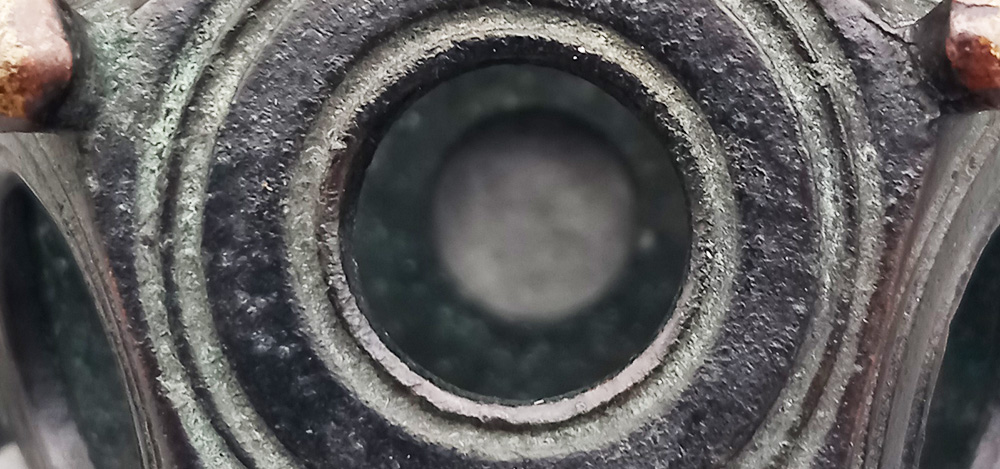
A magnified view of Face-hole 3.
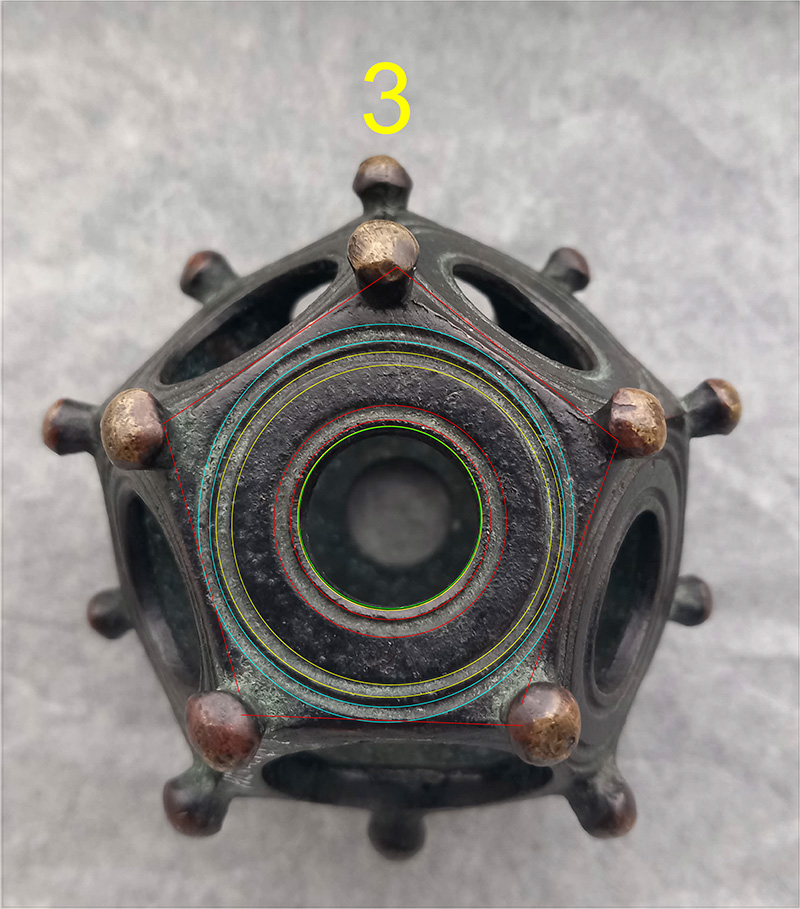
THE FACE 3 CIRCLE CODES
CENTRE HOLE
The Hunt Museum surveyors measured the diameter of this face hole to be 24.2 mm, which equates to .511811". The hole shows blended circles (yellow & green), the yellow one being the Hunt Museum measurement.
The sought-after diameter measurement of the fabricators was undoubtedly .512" (64/125ths) or about 1/530th of an inch increase (visually undetectable to the human eye). Simultaneously, this diameter would have been read as .5103" (1/666th of an inch less). The code-bearing number 5103 (days) is 3/4ths of the duration of the Lunar Nutation cycle.
A mathematical progression based upon .512 goes:
.512, 1.024, 1.536, 2.048, 2.560, 3.072, 3.584, 4.096, 4.608, 5.120 ... 7168 ... 9216 ... 12800 ... 13824 ... 18944 ... 20376 ... 38400 ... 64000 ... 69120 ... 130636800
Note: the sum of 69.12-miles was 1-degree of equatorial arc in the 24883.2-mile reading. The sum of 130636800' was considered to be the equatorial circumference of the Earth using the Greek mile of 5250'.
The 512 value is an expression of: 2, 4, 8, 16, 32, 64, 128, 256, 512, etc., and infers subdivisions within a 320-division circle This is what mariners and others have traditionally done since time immemorial in the reading of degrees within a 360-degree compass environment. We therefore have compass bearings as 180, 90, 45, 22.5, 11.25, etc., or 320th divisions within 360-degrees.
The diameter of .5184" would also have been read as representing this face-hole diameter @ (324/ 625ths) or an increase of about 152nd of an inch (also visually undetectable to the human eye).
A mathematical progression based upon .5184 goes:
.5184, 1.0368, 1.5552, 2.0736, 2.592, 3.1104, 3.6288, 4.1472, 4.6656, 5.184 ... 1036.8 ...6220.8 ... 7776, 82944 ... 93312 ... 18662.4 ... 12441.6 ... 24883.2 ... 25920.
In the above string, the number 1036.8 is generated and, in miles. would be 1/24th of the 24883.2-mile equatorial circumference of the Earth. By consequence, 1036.8 mph would be the speed at which the Earth spins in 24-hours.
Also, 5184-years would be 1/5th of the duration of the Precession of the Equinoxes (25920-years), where the calendar date of the equinox needs to change by 1-day every 72-years to remain correct ... (360 X 72 = 25920).
The slope angle of the Great Pyramid is 51.84°. Each side of the Great Pyramid's base is 756' long or 72 Hebrew reeds of 10.5' (1-reed is 10 Greek feet @ 12.6"each). This means that the Great Pyramid occupies 72 X 72 square reeds of ground space or 5184 sq reeds.
Also, there were several variations on the PI ratio (converting a diameter into a circle) in use by ancient mathematicians, depending on the number family being calculated. The values generated within the 5280'-mile set of increments were based upon an "11" family of numbers, and for this family the rendition of PI used was 1728/550ths or 3.141818182. This means that the ancient English league @ 16500' (3.125-miles), when converted to a circumference = 51840'... ÷ 360° = 144' per degree of arc. This was essential knowledge for sea legs (leagues of travel) on the featureless oceans, when zigzagging under sail back & forth across a leyline to a destination. Each scaled zig or zag of travel had to be drawn on a plotting chart or slate, converted into a circle, then the angle back to the point of departure or onwards to the destination could be known ,,, dead-reckoning at sea.
In the above string, 362880' would be 1-degree of equatorial arc when traveling by the 5250'-mile, which was adopted by the Greeks from much older civilisations (primarily the Egyptians). The sum of 1555.2-miles would be 1/16th of the equatorial circumference with 3110.4-miles being 1/8th, 6220.8-miles 1/4th, 12441.6-miles 1/2, 18662.4-miles 3/4ths & 24883.2-miles the full circumference.
FIRST OUTER CONCENTRIC RING ... RED CIRCLE
(1). The red circle inner ring of the 2nd outwards circle has a diameter of .5625" (9/16ths)
A mathematical progression based upon .5625 goes:
.5625, 1.125, 1.6875, 2.25, 2.1825, 3.375, 3.9375, 4.5, 5.0625, 5.625, 6.1875, 6.75 ... 7.875 ... 9 ... 10.125 ... 11.25, 11.8125, 12.375 ... 13.5 ... 15.75 ... 18 ... 19.6875 ... 22.5 ... 24.75 ... .90 ... 180 ... 270 ... 315 ... 354.375 ... 360 ... 472.5 ... 495 ... 540 ... 590.625 ... 630 ... 708.75 ... 720 ... 990 ... 1080 ... 1215 ... 1260 ... 2835 ... 248832 ... 130636800.
For a Druidic astronomer-navigator, this is a power-packed string, which divulges a huge amount of information. It provides the values for reading the 360° compass, segmented down into 32nd, 16th, 8th, 4ths, 1/2. 3/4ths parts and the full circuit. It identifies the 3-4-5 triangle codes of the Khafre Pyramid of Egypt (a pyramid of the moon) as half the base length = 354.375' ... 3 X 118.125-days (12 lunar months of 29.53125-days ... 29 & 17/32nds); the pyramid's height = 472.5' ...4 X 118.125-days (16 lunar months); The sloping faces of 590.625' ... 5 X 118.125 (20 lunar months). It then goes on to divulge the length of the Khafre Pyramid, as well as the whole perimeter value.
Within a full readout of the string are all the numbers relevant to the very important Lunar Nutation cycle (ie) 850.5-days (1/8th); 1701-days (1/4th); 3402-days (1/2); 5103-days (3/4ths); 6804-days (the full duration).
The string goes on to give the numbers relevant to divisions within the equatorial size of the Earth.
SECOND OUTER CONCENTRIC RING ... RED CIRCLE
(2). The red outer ring of this 2nd outwards circle is .6534" (3267/5000ths).
A number string based upon .6534 goes:
.6534, 1.3068, 1.9602, 2.6136, 3.267, 3.9204, 4.5738, 5.2272, 5.8806 ... 6534 ....130680000
The sum of 6534' is 1/20,000th of the equatorial size of the Earth under the navigational system that uses the mile of 5280'... 24750-miles or 130680000'. The same circle diameter would be mnemonically read as 6531.84 and relate to the 24883.2-mile reading using the shorter 5250' Greek mile ... 24883.2 such miles or 130636800'.
THIRD OUTER CONCENTRIC RING ... YELLOW CIRCLE
(3). The yellow circle inner ring of the 3rd outwards concentric circle has a diameter of .9" (9/10ths), which also would have been read as .9072" (567/625ths) and .9075" (363/400ths).
This would, of course, be simply read as .9, 1.8, 2.7, 3.6, 4.5, 5.4, 6.3, 7.2, 8.1, 9, 9.9, 10.8, 11.7, 1.26, etc ... or the nine-times-table from primary or grade school. However, in the upper reaches of the progression are a huge selection of 360° compass, lunar-cycle, navigational, Great Pyramid and equatorial circumference of the Earth values.
As stated, this diameter would have mnemonically recalled .9072" & .9075" & relate to the navigational method that used the 5250' mile and the method that used the 5280'mile, respectively.
FOURTH OUTER CONCENTRIC RING ... YELLOW CIRCLE
(4). The yellow outer circle has a diameter of .972" (243/250ths).
A number string based upon .972 goes:
.972, 1.944, 2.916, 3.888, 4.86, 5.832, 6.804, 7.776, 8.748, 9.72 ... 11.664 ... 14.58, 15.552 ... 19.44 ... 243 ... 272.16 ... 486 ... 622.08 ... 729 ... 850.5 ... ... 3110.4 ... 1701... 3402 ... 5103 ... 6804 ... 24883.2 ... 130636800
The sum of 9.72-miles would be 1/256th of the 24883.2 equatorial circumference; 194.4-miles would be 1/128th; 388.8-miles would be 1/64th; 777.6-miles would be 1/32nd; 1555.2-miles would be 1/16th; 3110.4-miles would be 1/8th; 6220.8-miles would be 1/4th; 12441.6-miles would be 1/2; and 24883.2-miles the full equatorial circumference.
At the same time the Lunar Nutation cycle of 6804-days was similarly segmented into intervals within this progression ... 850.5 -days (1/8th); 1701-days (1/4th); 3402-days (1/2); 5103-days (3/4ths) & 6804-days for the full duration.
FIFTH OUTER CONCENTRIC RING ... CYAN CIRCLE
(5).. The cyan ring of the 5th outwards concentric, slightly elliptical circle has a horizontal diameter of 1" and a vertical diameter of 1.03125" (1 & 1/32nd)).
A mathematical progression based upon 1.03125 goes:
1.03125, 2.0625, 3.09375, 4.125, 5.15625, 6.1875, 7.21875, 8.25, 9.28125, 10.3125 ... 20.625 ... 12.375 ... 16.5 ... 24.75 ... 33 ... 495 ... 660 ... 7920 ... 9075 ... 24750 ... 130680000.
An ancient English furlong or furrowlong (660' or 7920" ) equates to 384 Egyptian Royal cubits of 20.625". This was the mid-range cubit that worked with the mile of 5280' (3072 ERC of 20.625" ... 20 & 5/8ths). An ancient English league (3.125-miles or 16500') was 9600 such cubits. The ancient English chain, 66', was 38.4 ERC and their rod or perch 16.5' (3 ancient fathoms of 5.5' each) was 9.6 ERC of 20.625".
The other two Egyptian Royal cubits, 20.61818182" ... (20 & 3090/5000ths) and 20.736" ... (20 & 92/125ths) would also have been mnemonically represented in this diameter. Each was for mnemonic recall of the equatorial size of the Earth under slightly different navigational methods.
SIXTH OUTER CONCENTRIC RING ... CYAN CIRCLE
(6).The cyan outer ring has a horizontal diameter of 1.056" (1 & 7/125ths) and a vertical diameter of 1.12". (1 & 3/25ths).
A mathematical progression based upon 1.056" goes:
1.056, 2.112, 3.168, 4.224, 5.28, 6.336, 7.392, 8.448, 9.504, 10.56 ... 15.84 ... 19.008 ... 26.4 ... 28.512 ... 47.52 ... 101.376 ... 1320 ... 5280 ... 7920 ... 247500 ... 130680000.
This string contains numbers related to the equatorial circumference of the Earth under the 5280' mile method of navigation The inch values of the string are divisible by the Egyptian Royal cubit @ 20.625".
A mathematical progression based upon 1.12" goes:
1.12, 2.24, 3.36, 4.48, 5.6, 6.72, 7.84, 8.96, 100. 8, 112 ... 1344 ... 1680 ... 2016 ... 2688 ... 2800 ...3024 ... 3584 ... 4032 ... 5040 ... 5376 ... 5600 ... 6048 ...6720 ... 7168 ... 8400 ... 9072 ... 1209.6 ... 1400 ... 1512 ... 362880 ... 130636800.
This string contains numbers that found their way into traditional weights standards ... (ie) 2240 lbs (pounds) in a ton, consisting of 20 cwt (hundred-weight) of 112 lbs each, with each cwt being 8 stone and each stone being 14lb (7000 grains)..
It also contains 100.8 (in feet = 1-second of equatorial arc), 3024 (in feet = 1/2 a minute of equatorial arc); 6048' = 1-minute of equatorial arc; 362880' = 1° of equatorial arc and 130636800' for the full equatorial circumference.
FACE 4 CIRCLE CODES.
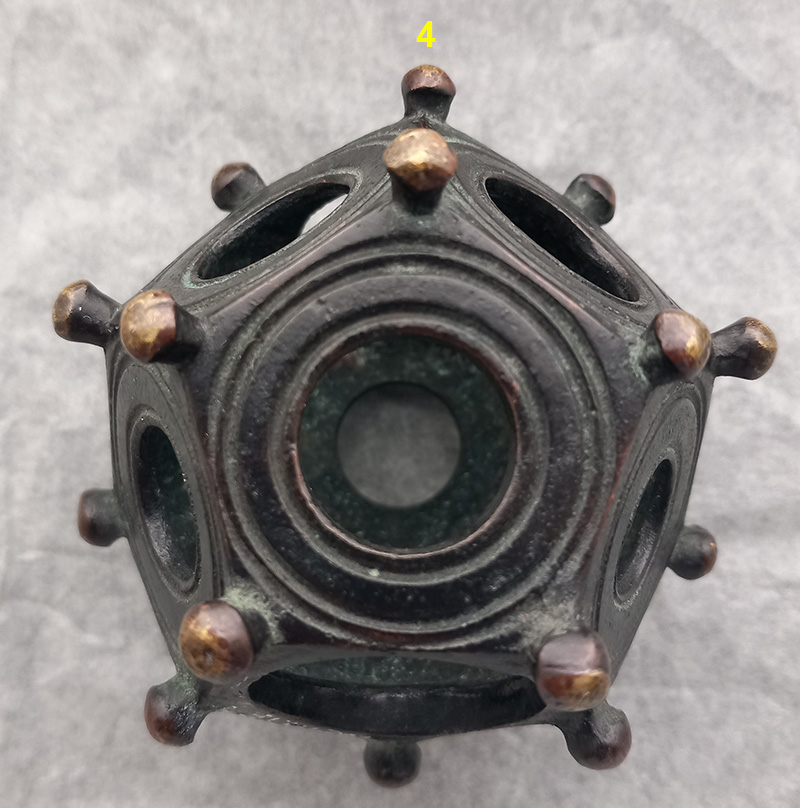

Magnified image of Face 4 hole.
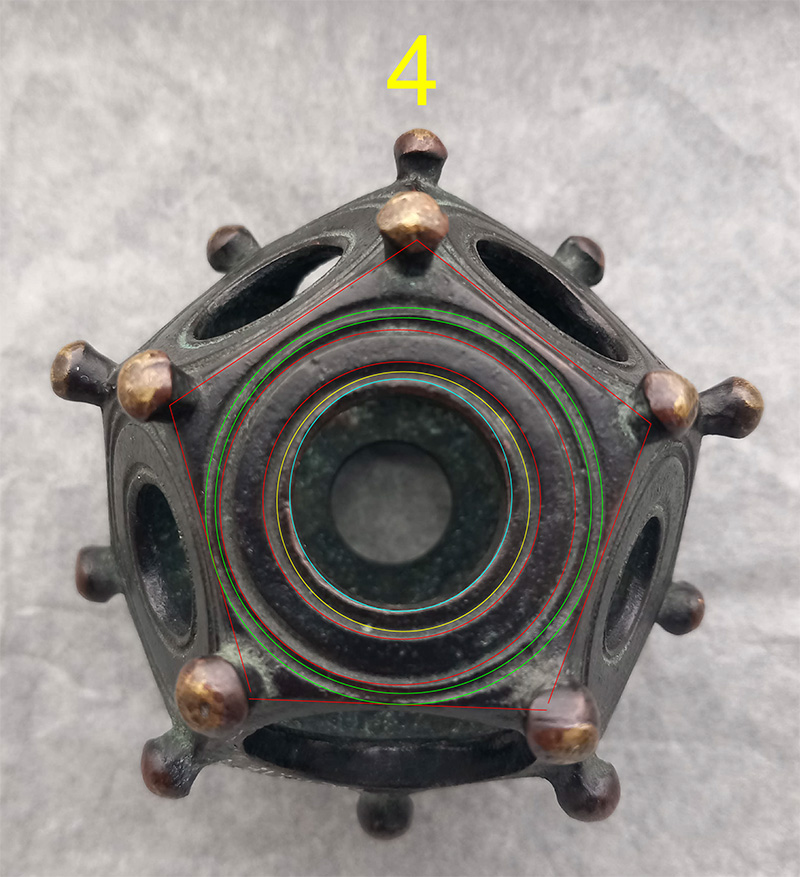
THE FACE HOLE DIAMETER
The Face 4 hole diameter was determined to be 15.7 mm, converting to .6181102" ... cyan circle.
The hole is also slightly elliptical, with an intended height of .6180334" (the PHI reciprocal or 1" ÷ 1.6180339) which value was used for making perfect capacity, circular, marketplace tubs for dispensing grain.


The Bush Barrow Lozenge measurements are 6.18034” high X 7.29” long.
A primary purpose of the Bush Barrow Lozenge appears to have been for "market-place" inspectors to check the base width of "Bushel" barrels and tubs used by ancient merchants of the Neolithic Age, extending to Mediaeval times.
Very slightly "drifted" dimensions, for building a "Bushel" capacity tub, are described in the old English Winchester Standard as: "Any round measure with a plain and even bottom, being 18.5 inches wide throughout and 8 inches deep".
In fact, that should be 3 X 6.18034” or 18.54102” (a shortfall of 1/25th of an inch).
For a king or provincial governor/ priest, trying to keep peace within regional society, few things were more threatening to harmony than "short measures" being meted out in the market place. This problem has required eternal vigilance, worldwide, since time immemorial. The responsibility to know what constitutes a correct measure in weight, volume or length, as well as the enforced maintenance of precise standards, was always a primary function of localized leadership.
The original bushel of England was, undoubtedly, based upon a Sumerian/ Babylonian volume called a Homer, which was 21600 cubic inches. The English Winchester bushel @ 2150.42 cubic inches was very close to 6 X 6 X 60 cubic inches (2160 cubic inches...1/10th of a Homer).
The surviving volume from the old English Winchester Standard, (as described at a late epoch of history), undoubtedly had a pedigree founded upon older traditions, passed down from distant ancestors.
In the opinion of this researcher, the Winchester bushel represents a "drifted" standard from very olden times, inasmuch as the 2150.42 cubic inch volume is without meaning, whereas a 2160 cubic inch volume would be highly significant. It seems plausible to assume that the original coding of the bushel was "navigational" and also related to the 25920-year duration of the Precession of the Equinoxes, where the sun spends 2160-years in each House of the Zodiac, before moving to another house.
This exact description for a bushel (given above) became the volume of the American bushel, which is 2150.42 cubic inches ...derived directly from the old Winchester Standard and, thankfully, still preserved in the USA.
Using the PHI based rendition listed above @ 6.18034 inches the final capacity is: 6.18034 X 3 = 18.54102 inches ÷ 2 = 9.27051 (squared) = 85.94235566 X PI = 269.999 square inches X 8 = 2160 cubic inches...with a margin of error of .033 of a cubic inch.
This is how ancient savants "squared the circle" ... by using the PHI reciprocal.
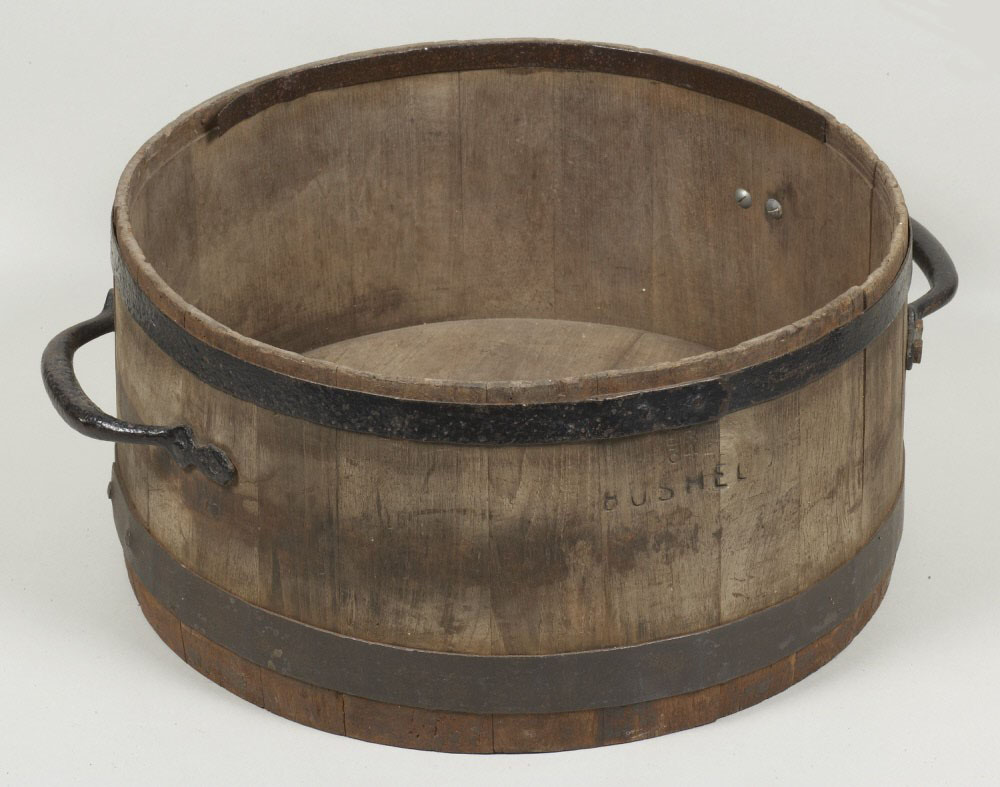
The base floor of the British Bushel was 270 square inches, with walls rising above the base floor a total of 8-inches, for a cubic capacity of 2160 cubic inches.
Note: With the Sun spending 2160-years in each house of the Zodiac before moving into a new house, at the Vernal Equinox, we are presently in the House of Pisces but will move into the House of Aquarius next.
BUT DOES THIS FORMULA WORK FOR OTHER COUSIN CICILISATIONS?
How about the Viking Tunnah?
The increment of 6.18034 X 2 = 12.36068-inches. This value equates to 1.03005666 feet and is assuredly the measurement identified by researcher Gary Anderson as the largest "Fot" utilised by the Vikings.

To make the Tunna tub base, take a large thin slab of flat smooth timber or tightly edge-splice several planks together to form a single piece of sufficient size.
Next take the 1.0300566 foot rule and, from the centre, mark the double radius circle (2.0601132 feet) onto the wooden base as the total diameter.
Because you have used a rule derived directly from the PHI formula, your base is exactly 480 square inches of surface area.
Your formula for determining the square inch area is PI X the radius squared, memorised by every schoolchild in the formative years of their education. So, the diameter of 2.0601132 feet ÷ 2 = 1.0300566 feet = 12.3606792-inches. This value "squared" = 152.7863903 X PI (3.14159) = 480 square inches of base area.
The 480 number is a much-used coded value of antiquity and all aspects of ancient tub had to contain recognisable codes in the base surface area, internal side height and cubic capacity to be contained.
Because the tub needs to achieve 10080 cubic inches for this Swedish Tunna vessel, the internal height of the tub, from the top surface of the base to the brim of the side wall is 21-inches. This value (21-inches...sometimes called a Celtic Royal Cubit) is found in the base length of the Great Pyramid, which is 432 X 21-inches in length per side or 1728 X 21-inches for all four sides.
Note: A cubic foot (12 X 12 X 12) is 1728 cubic inches.
Note 2: A length of 100.8’ is one second of arc in the 24883.2 Greek mile (5250’) equatorial circumference of the Earth.
READING THE INBUILT CODES FOR EACH MARKED INCREMENT OF AN EGYPTIAN ROYAL CUBIT, INCLUDING 6.18034" AND 7.29"

One of several Egyptian Royal Cubits in the Turin Museum's collection ... this one being 20.61818182" in length.
CONCENTRIC CIRCLE CODES EMANATING FROM THE BASE EDGE OF THE LEFT-HAND SIDE

1. The first increment is a PHI inch or 1" X 1.6180339.
2. The second increment is a PI inch or 1" X 3.1416. This same division would be mnemonically coded to be 1" X 22/7ths; 1728/ 550ths; etc., depending upon the calculation need within an individual number family.
3. The third increment (a circle with a diameter of 4.6656") identifies the navigation-related number 46656 ... a marker on the Avenue at Stonehenge sits 233.28' from the site-centre, forming a circle with a diameter of 466.56'.
4. The fourth increment is 6.18034". This is the PHI reciprocal (10" ÷ 1.6180339 = 6.18034" ... the unit of measurement for squaring the circle, when making perfect circular marketplace tubs for dispensing grain.
5. The fifth increment identifies the number 756'... for the length of the Great Pyramid (based upon a mile of 5250'). It also infers 756.25' for another navigational system (Earth equatorial circumference) based upon the mile of 5280.
6. The sixth increment identifies the number 9, as in 90, 180, 270 & 360° respectively.
7. The seventh increment identifies the number 10.4. The half value is 5.2, as in 52 weeks in the year. Other significant, close proximity codes, such as 51.84 or 52.5, would also have been mnemonically recalled at this position.
8. The eighth increment identifies the number 11.8125". The sum of four lunar months @ 29.53125-days is 118.125-days. The 3-4-5 triangle geometry of Khafre Pyramid is based upon 118.125'.
9. The ninth increment is based upon a full circle of 13.2" diameter. The sum of 132' is 1/40th of a mile of 5280'. The sum of 13.125" would have been mnemonically recalled also, related to 1/40th of the 5250' mile.
10. The tenth increment is the diameter of a circle 14.66666" wide. This is navigational coding and 14.66666' is 1/360ths of the 5280' mile. This position would mnemonically recall 14.58333' (1/360th of the 5250'mile).
11. The eleventh increment is 16", a multi-use number for many calculations, especially traditional divisions in a 360° circle .
12. The twelfth increment is 17.5", which was a very important increment in Greek metrology, adopted from much earlier civilisations. The sum of 175' is 1/30th of the Greek mile of 5250'.
13. The thirteenth increment is 18.9". The sum of 189' is 1/4th the design length of the Great Pyramid.
In the hieroglyphs sitting above each increment, an arm showing the elbow to the tip of the fingers, pointing to the right, tells the reader of the rule that circle increases can resolve upon the increment's demarcation line. In the next section of the Egyptian Royal Royal Cubit, some increments are similarly designated, whereas others are not.
The objective of the second or right-hand section is to provide incremental boxes of coded length and divide increments into 16th, 15th, 14th, 13th, 12th, 11th, 10th, 9th, 8th, 7th, 6th, 5th, 4th, 3rd, & half parts.
THE RIGHT-HAND HALF OF THE EGYPTIAN ROYAL CUBIT
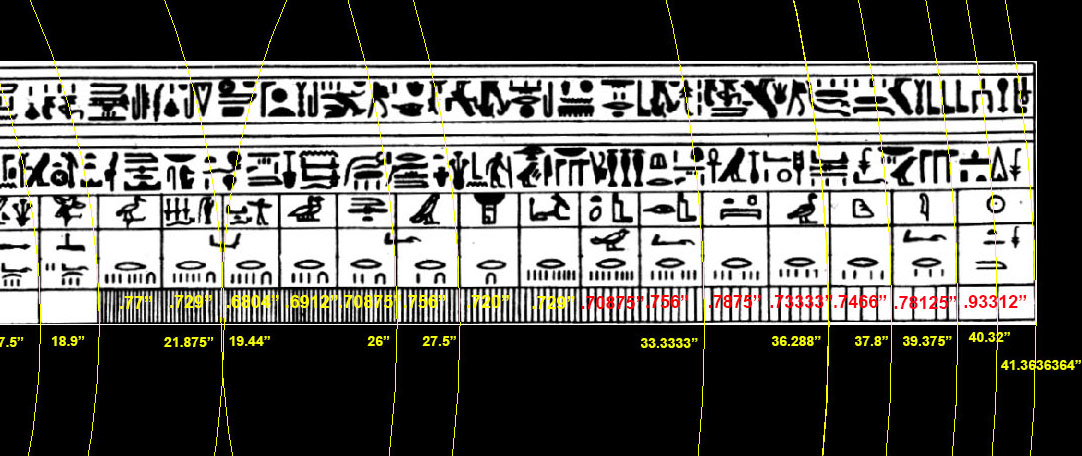
Whereas the hieroglyph of the arm and hand pointing to the right is shown above all the clear boxes to the left side of the Egyptian Royal Cubit, they sit only above a selected few of the calibrated boxes to the right hand side.
Where such an arm hieroglyph is present, the reader of the rule knows that a circle, extending from the left lower corner of the ERC, can resolve upon the demarcation line of the increment box and that the circle will act as a coded diameter.
There are two variations of the pointing arm, one of which is conjoined arms coming from each end of the ERC (left and right). At this juncture there are two circle diameter codes given (see the values 21.875" & 19.44"" in the above picture).
Another variation occurs at the 26" position, where the right pointing arm is drawn extending through two boxes. This indicates the presence of two circle diameter codes emanating from the left side of the ERC rule to resolve at the 26" & 27.5" positions.
Other very significant hits, although not marked by the extended arm & hand hieroglyph, occur at 36.288"and 37.8". The sum of 362880' was 1-degree of arc in the equatorial circumference of the Earth under the Great Pyramid's navigational assignment, whereas, using the mile of 5280', 1-degree of arc was 363000'.
The 37.8" diameter circle relates to the half length of the Great Pyramid (378').
Other circle-related hits occur at 39.375"and 40.32". The 39.375 code is primarily for lunar cycle calculations, but also includes 196.875 (grains) ... Beqa gold standard for weighing gold dust and used by the Egyptians, Greeks and Romans.
The sum of 4032' was 2/3rds of 1-minute of equatorial arc under the Great Pyramid's navigational system, with 6048' (two full circumnavigations of the pyramid ... 8 sides) equating to 1 minute of equatorial arc.
The full length of the ERC @ 20.61818182" X 1200 = 24741.81818184, which, read as miles of 5280' = 130636800' or 12 X 12 X 12 X 12 X 1.2 Greek miles of 5250' each ... (24883.2-miles)
The lengths within the calibrated boxes are as followed:
1. (16 calibration lines) ... length of box = .768" ... navigation; the equatorial circumference of the Earth.
2. (15 calibration lines) ... length of box = .729"... Roman metrology and navigational system; lunisolar Sabbatical Calendar of Coligny; equatorial circumference of the Earth; grain weight of the Babylonian Talent.
3. (14 calibration lines) ... length of box = .6804"... Lunar Nutation cycle duration.
4. (13 calibration lines) ... length of box = .6912"... One degree of Earth equatorial circumference (69.12-miles) under the 5280-mile navigational system.
5. (12 calibration lines) ... length of box = .70875"... Length of the Khafre Pyramid (708.75'); the lunar year; the lunar month; the Lunar Nutation cycle.
6. (11 calibration lines) ... length of box = .756" & .756.26"... Length of the Great Pyramid (756'); seconds, minutes & degrees of arc in the equatorial circumference of the Earth.
7. (10 calibration lines) ... length of box = .720"... The Precession of the Equinoxes; Bushel standard of capacity; equatorial diameter of the Earth; navigation, etc.
8. (9 calibration lines) ... length of box = .729"... as above.
9. (8 calibration lines) ... length of box = .70875"... as above.
10. (7 calibration lines) ... length of box = .756"... as above.
11. (6 calibration lines) ... length of box = .7875"... Greek metrology system; Khafre Pyramid dimensions; Great Pyramid dimensions; Beqa gold standard; Lunar Nutation cycle.
12. (5 calibration lines) ... length of box = .7.3333".... Navigation under the mile of 5280'; chain, furlong & league measurements; equatorial circumference of the Earth.
13. (4 calibration lines) ... length of box = .746666". Ton & hundredweight system of weights; equatorial circumference of the Earth.
14. (3 calibration lines) ... length of box = .78125"... Eighth divisions of decimal values.
15. (2 calibration lines) ... length of box = .93312"... The ancient Babylonian-Sumerian Talent weight of 933120 grains; The equatorial circumference of the Earth.
It would seem that this section is simply demonstrating the methods for dividing up the numbers, using all the number families, to create a full range of number strings.
OTHER TUB CAPACITIES OF THE GREAT CIVILISATIONS OF EUROPE, THE BRITISH ISLES & MEDITERRANEAN
The 6.18034" (PHI reciprocal) formula for making perfect capacity round tubs for the marketplace (of varied capacities), was obviously used by many mathematically-advanced nations / civilisations
Here are some examples:
-
1 Egyptian Theban @ 11664 cubic inches...6.75 cubic feet. A Theban would be 5.4 ancient bushels of 1.25 cubic feet.
-
1 Greek Metretes @ 2332.8 cubic inches...1.35 cubic feet. A Metretes would be 1.08 ancient bushels of 1.25 cubic feet.
-
1 Hebrew Homer @ 28512 cubic inches... 16.5 cubic feet. A Homer would be 1.32 ancient bushels of 1.25 cubic feet.
-
1 Roman Amphora @ 1900.8 cubic inches...1.1 cubic feet. An Amphora would be .88 ancient bushels of 1.25 cubic feet.
-
1 Babylonian Archane @ 129600 cubic inches...75 cubic feet. An Archane would be 60 ancient bushels of 1.25 cubic feet.
Although the cousin nations made their measures either the same or in easily-calculated ratios to their trading neighbors, they also required precise formulas for fashioning very individual circular jar or tub vessels for their own coded volumes of preference. It would appear, very strongly, that the 6.18034 inch increment was used universally to calculate the bases for all "official standard" measuring tubs or vessels used by the great civilisations of the ancient Mediterranean Basin. For example:
- 1 Egyptian Theban tub @ 11664 cubic inches could have a circular base of 18.54102 inches (3 X 6.18034") and sides 43.2 inches high. There would be 270 X 43.2 cubic inches in 11664 cubic inches The length of the Great Pyramid is 432 Hebrew/ Celtic Royal Cubits of 21-inches).
- 1 Greek Metretes vessel @ 2332.8 cubic inches (actually a liquid volume) could have a base diameter of 12.36068 inches (2 X 6.18034") and sides 19.44 inches high. The 19.44 number was used for lunar calculations and the Roman Pace @ 58.32 inches was 3 X 19.44 inches. There would be 120 X 19.44 cubic inches in 2332.8 cubic inches.
- The Hebrew Homer @ 28512 cubic inches could have a circular base diameter of 30.9017 (5 X 6.18034") and sides that were 38.016 inches high. The number 38.016 is a navigational-use number and the Roman Amphora @ 1900.8 cubic inches was 50 X 38.016. Alternatively the Hebrew Homer @ 28512 cubic inches was 750 X 38.016 cubic inches.
- The Roman Amphora @ 1900.8 cubic inches could have a circular base diameter of 12.36068 inches (2 X 6.18034") and sides 15.84 inches high. The 15.84 number was used in navigation and there would be 120 X 15.84 cubic inches in 1900.8.
- The Babylonian Archane @ 129600 cubic inches could have a circular base diameter of 49.44272 inches (8 X 6.18034") and sides that extended above the base 67.5 inches. The number 129600 was used in navigation. The sum of 12960 years is half the cycle of the Precession of the Equinoxes. There would be 1920 X 67.5 cubic inches in 129600 cubic inches.
Any precise volume standard used by the cousin nations could be fashioned with tremendous precision as a circular vessel when the base diameter was in allotments of 6.18034 inches. The vessels could be more squat than tall or vice-versa... it didn't matter, as long as the base retained the 6.18034 inch progression in it's diameter. The same formula, in lesser ratio, could be used to fabricate tumblers, jars or everything down to small cups for use by wine, beer or mead vendors within commercial premises.
The 6.18034 number could also be pressed into service if it was necessary to lay out circular land plots of precise square footage area. For example, an Egyptian Pyramid Acre of 28800 square feet would be a circle with a diameter of 31 X 6.8034 feet. An acre of 43560 square feet (1 furlong X 1 chain) would be a circle of 38.1 X 6.18034 feet.
It seems evident that the old Scottish Ell (37 inches) was, quite simply, 6 X 6.18034 inches originally (37.08204 inches). The Scottish Ell would work very fluidly in laying out circles of desired square footage area with reasonable calculation ease. This is, undoubtedly, one of the surviving measurements carried from Egypt to France and Britain by about 5000 BC. Half a Scottish ell could be used effectively to make bushel barrels or tubs.
It is this researcher's conclusion that the intended, original width of the Bush Barrow Lozenge and the intended, original length of the Clandon Barrow Lozenge were 6.18034 inches ... a direct reflection of the PHI ratio...10 inches ÷ 1.6180339. In consideration of the known cubic capacities of ancient Mediterranean Basin volume vessels, no other internal measurement for diameters within round marketplace tubs would be more important.
As an interesting exercise to see if the length value of the Bush Barrow Lozenge (7.29" ... inferring or encoding 7290 as a cubic inch volume) could be easily achieved, let's apply the selfsame "bushel" formula ... as all one would have to do is increase the side height above the base from 8" to 27" ... et voilà! ... the capacity is now 7290 cubic inches.
There was a variation on the Greek foot (12.6") that was called the Samos foot (12.15") and 729 feet of 12" = 720 Samos feet. The Samos foot was used for calculating lunar cycle durations. Also, 7.29" was 1/8th of what became known as the Roman Pace measurement of 58.32".
A number string based upon 12.15 goes:
12.15, 24.3, 36.45, 48.6, 60.75, 72.9, 85.05, 97.2 ... 121.5 ... 145.8 ... 1701 ... 194.4 ... 255.15 ... 291.6, 303.75 ... 340.2 ... 510.3 ... 680.4 ... 4860 ... 5832 ... 7290 ... 131220
As can be seen the values 850.5; 1701; 3402; 5103 & 6804 represent 1/8th, 1/4th, 1/2, 3/4ths & the full duration of the Lunar Nutation cycle in days ... the actual duration being 6798.36-days, but ancient savants used the easily divisible number 6804-days to describe the cycle in fluid breakdown form, all the way to the last day, hour, minute or second.
THE 90° OPPOSED DIAMETER OF THE CENTRE HOLE
The 90° opposed cross measure diameter is .590625" (189/320ths), a very strong lunar code. This could also be symbolically read as .5940" (297/500ths) ... Scottish mile.

As stated, the Khafre Pyramid was built as two back-to-back 3-4-5 triangles, where the half-base was 354.375' (which, in days, = the lunar year or 3 X 4 lunar months); the design height is 472.5' (4 X 4 lunar months) and the face hypotenuse is 590.625' (5 X 4 lunar months).
Note: half of 59.0625 = 29.53125 which, in days, is a lunar month to a tolerance of under 1-minute.
FIRST OUTER CONCENTRIC RING ... YELLOW CIRCLE
(1) This rim diameter beyond the centre hole is .672" ... ancient Irish mile code (6720').
A number string based upon 672 goes:
672, 1344, 2016, 2688, 3360, 4032 ... 5376, 6048, 6720 ... 8064 ... 10080 ... 12096 ... 16800 ... 36288 ... 50400 ... 54432 ... 130636800.
In the above lineup 2016' is 1/3rd of 1-minute of equatorial arc, with 4032' and 6048' being 2/3rds and 1-minute of arc, respectively. The sum of 100.8' would be 1-second of arc for the Earth's equatorial circumference under the Great Pyramid's navigational coding. The sum of 362880'would be 1-degree of arc and 130636800'would be the equatorial circumference of the Earth. The Greek mile of 5250' X 1.28 = 6720' (the ancient Irish mile). The ancient Irish mile was 1440' larger than the English mile of 5280' and 780' larger than the Scottish mile of 5940'.
SECOND OUTER CONCENTRIC RING ... RED CIRCLE
(2). The diameter is .73828125" (189/256ths) ... This is a coded value for the lunar week (7 & 49/128ths days ... 177.1875 hours ... Note: The Lunar month of 29.53125-days ÷ 1.6666666 = 17.71875-days ) ... also the sum of 177.1875-days is half a lunar year of 354.375-days.
THIRD OUTER CONCENTRIC RING ... RED CIRCLE
(3). The diameter is .945" (189/200ths) ... Great Pyramid navigation.
A number string based upon 945 goes:
94.5, 189, 283.5, 378, 472.5, 567 ...756, 850.5, 945... 1134 ... 1417.5, 1512 ... 1701 ... 2268 ... 2551.5 ... 2835 ... 3024 ... 3402 ... 4536 ... 4725 ... 5103 ... 6048 ... 6804 ... 7087.5 ... 9072 ... 11812.5 ...130636800.
This string alternates between Khafre Pyramid base dimensions and Great Pyramid base dimensions. Therefore: 94.5' would be 1/30th of the 2835' Khafre base perimeter, as well as 1/32nd of the 3024' Great Pyramid base perimeter. It also gives the 1/8th, 1/4th, 1/2, 3/4ths and full duration lunar nutation cycle of 6804-days.
The sum of 2551.5-days was the lunar period (7.2-lunar years) tracked alongside 7-solar years (2556.5-days) in the Lunisolar Sabbatical Calendar count. This was the counting method used over the Calendar of Coligny bronze parapegma plaque found in France in November 1897.
FOURTH OUTER CONCENTRIC RING ... GREEN CIRCLE
(4). The diameter is 1".
This is simply coding the increment of one standard inch..
FIFTH OUTER CONCENTRIC RING ... GREEN CIRCLE
(5). The diameter is 1.056" (1 & 7/125ths).
A number string based upon 1056 goes"
1056, 2112, 3168, 4224, 5280, 6336 ... 9504, 10560 ...15840 ...19008 ... 26400 ... 28512 ... 13200 ... 79200 ... 130680000
This string relates to navigation by the mile of 5280 feet and 130680000' would be 24750-miles for the equatorial circumference of the Earth under that navigational system.
FACE 5 CIRCLE CODES
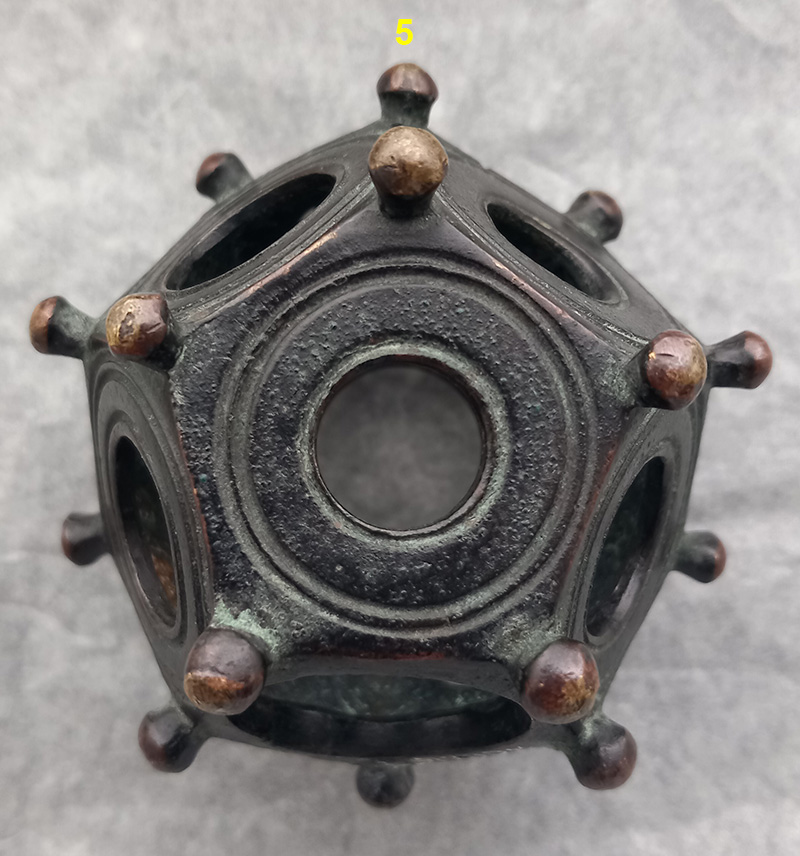

Magnified image of Face 5 hole.
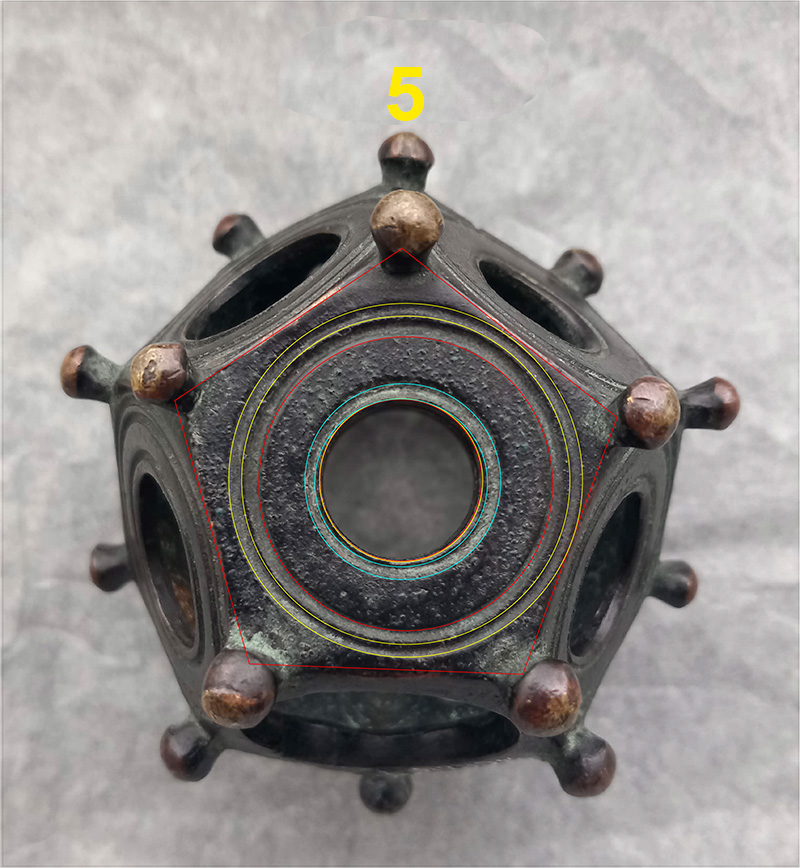
This face-hole was measured by the Hunt Museum personnel to be 11.9 mm, which converts to .4685039".
The intended diameter was .46875" (about 1/4075th of an inch increase) and a number string based on this goes:
.46875, .9375, 1.40625, 1.875, 234375, 2.8125, 3.28125, 3.75, 4.21875, 4.6875, 5.15625, 5.625 ... 7.5 ... 11.25 ... 15 ... 17.8125 ... 19.6875 ... 30 ... 45 ... 60 ... 90 ... 360 ... 5250... 130636800.
The above string contains dynamic numbers, associated with the 360° compass, the Beqa gold standard of the Egyptians, Greeks & Romans (196.875 grains), leading all the way up to the equatorial circumference of the Earth.
The ancient savants, involved as they were in navigation around the globe or breaking down the celestial cycles into bite-size fractions, created multiple strings like this so that they could subdivide within a range of mathematical options.
The .46875 fraction translates to 15/32nds. When looking at the 130636800' equatorial circumference of the Earth figure in terms of a 360° circle, 1/32nd segment would be 11.25-degrees. Since time immemorial navigators on land or sea have traditionally read 360° circles in 320 divisions ... 1/2, 1/4, 1/8th/, 1/16th/, 1/32nd, 1/64th, etc., as far as it is practicable.
In the above use of a 15/32nds division of the Earth's circumference, 1/32nd segment would be 777.6-miles of 5250' each. Further subdividing this into 1/15th parts would equate to 51.84-miles.
These are some of the most used values from the ancient parcel of special numbers. This distance (51.84 Greek miles) would also equate to .75 of 1-degree of equatorial arc.
Note: The slope angle of the Great Pyramid is 51.84°; The ground area that the Great Pyramid covers is 72 X 72 square reeds (Hebrew & Greek) of 10.5' each = 5184 sq reeds; An ancient British league (16500' or 3.125-miles of 5280' each) of straight line travel converts to a circumference of 51840' (divisible by 360°) using PI @ 1728/550ths (this attribute was used for positional plotting in sea-legs of travel by the league); The cycle of the Precession of the Equinoxes endures for 25920-years or 5184-years X 5.
By using 51.84-miles (.75 of 1° of equatorial arc) the value for .75 of a degree converts to a lunar code number. Thus: 362880' is reduced to 272160'.
Note: 272160-days would equate to 354.375-days (the lunar year) X 768. Also, 272160-days would be 40 X 6804-days (the duration of the Lunar Nutation cycle).
We could extend this analysis of the .46875 value to see how it applies to the 130680000' (24750-miles of 5280' each) reading of the equatorial circumference.
Under this system the value for 1-degree of equatorial arc is 363000' and .75 of that figure is 272250' or 51.5625-miles of 5280' or 158400 Egyptian Royal Cubits of 20.625"each.
Note: If "Noah's Ark", said to be 300 cubits in length, was based upon the Egyptian Royal Cubit of 20.625", then its length would be 515.625'.
Note 2: 272250' is 51 & 6/7ths Greek miles of 5250' each.
The sum of .468375 is 1/768th of 360°. At stonehenge, one cross measure of the site, extremity to extremity, is 384' or 1/2 of 768'.
As convoluted as all this might seem in a computer age, we must remember that ancient savants had to have manual calculations systems or tools, like an abacus, coupled with well developed memories and mnemonic devices, like the dodecahedron for periodic recall of numbers by rote and repetition.
CLOSE PROXIMITY CODES
This diameter was intended by the Druid fabricators to also encode both .4725" (1/250th of an inch more ... visually undetectable) and .4536" (1/68th of an inch less ... within human visual detection. Traditionally, old-time carpenters, doing finish work, could work to tolerances of 1/32nd of an inch and cabinet makers, using jigs, could achieve 1/64th of an inch or better).
The yellow-red colour blended circle shown above is a combination of the Hunt Museum measurement and .4725", whereas the green circle has a diameter of 4536". This second close-proximity number would, at least, have been mnemonically recalled in or near the hole diameter.
The number .4725 is 189/400ths. The number .4536" is 567/1250ths.
FIRST OUTER CONCENTRIC RING ... CYAN CIRCLE
(1). The diameter is .5" ... cyan circle.
This is simply 1/2 of an inch, but would also have represented .504".
A number string, based upon 50.4 goes:
50.4, 100.8, 151.2, 201.6, 252, 302.4 ... 403.2, 453.6, 504, 604.8 ... 756 ... 907.2 ... 1209.6, 1260 ... 1360.8 ... 1512 ... 2268 ... 3024 ... 6048 ... 6804 ... 362880 ... 130636800.
This string provides the side length of the Great Pyramid in both feet and inches (756' & 9072" respectively). It also provides the values for 1-second (100.8'), 1-minute (6048') and 1-degree (362880') of Earth's equatorial circumference arc, all the way up to the full circumference in feet (130636800').
It also provides the vertical height of the Great Pyramid to the level of its flat observation floor (453.6') ... in all recorded history it was always seen to be a truncated pyramid.
The value 6804 also occurs, identifying the duration, in days, of the Lunar Nutation cycle.
SECOND OUTER CONCENTRIC RING ... CYAN CIRCLE
(2). The diameter is .567 (567/1000ths).
A number string based upon 56.7 goes:
56.7, 113.4, 170.1, 226.8, 283.5, 340.2, 453.6, 510.3, 567 ... 680.4... 850.5, 907.2 ... 1360.8, 1417.5... 1701 ... 2551.5 ... 2835 ... 3402 ... 5130 ... 6804 ... 362880 ... 130636800.
Again, the lineup provides Great Pyramid and Khafre Pyramid essential numbers, as well as the 1/8th, 1/4th, 1/2, 3/4ths, and full duration of the Lunar Nutation cycle. It also provides Earth's equatorial circumference values, all the way up to a full circumnavigation under the Great Pyramid's navigational assignment.
The Station stones rectangle at Stonehenge is 264' long and 113.4' wide.
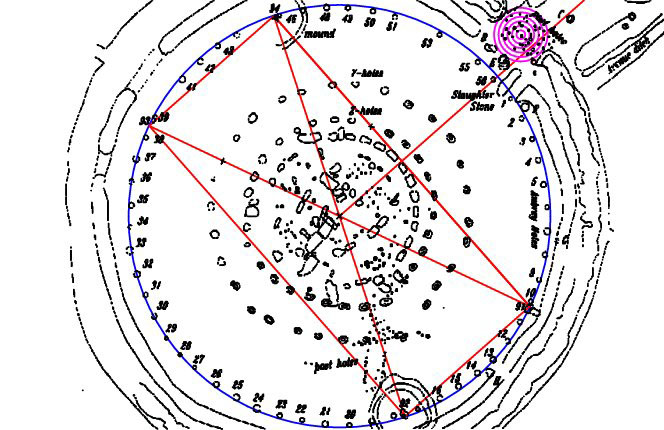
The Station Stones Rectangle at Stonehenge.
THIRD OUTER CONCENTRIC RING ... RED CIRCLE
(3). The diameter is ,8505" ( 1701/2000ths).
The sum of 850.5-days is simply 1/8th of the 6804-day Lunar Nutation cycle (6798.36-days actual, but counted as 6804-days for easy calculation divisions of the cycle) ... Lunar Major Standstill to Lunar Minor to Lunar Major again.
FOURTH OUTER CONCENTRIC RING ... YELLOW CIRCLE
(4). The diameter is .9504" (594/625ths).
A number string based upon 950.4 goes:
950.4, 1 900.8, 2851.2 ... 4752 ... 9504 ... 19008 ... 23760 ... 130680000
Although this is appears to be a somewhat complex string, the doubled value of 950400 (1900800) works well in providing the value for 1-degree of equatorial circumference arc under three navigational systems
-
The true equatorial circumference of the Earth (131383296 feet) ÷ 1900800 = 69.12. This figure (read in miles) would be 1-degree of arc for the world under the 24883.2-mile (true size) assignment. An Amphora @ 1900.8 cubic inches = 1.1 cubic feet and provides a mathematical progression related to navigation using the "11" series (league, mile, furlong).
-
The "11" series (league, furlong) circumference of the Earth (130680000 feet) ÷ 1900800 = 68.75 (read as miles) would be 1-degree of arc for the world under the 24750-mile assignment.
-
The "6 & 7" series (yard or reed) circumference of the Earth (130636800 feet) ÷ 1900800 = 68.727272 (read as miles) would be 1-degree of arc under the sexagesimal/ septimal system.
FIFTH OUTER CONCENTRIC RING ... YELLOW CIRCLE
(5). The diameter is 1.024" (1 & 3/125ths).
A number string based upon 102.4 goes:
102.4, 204.8, 307.2 ... 512 ... 921.6, 1024 ... 1536 ... 2560 ... 4608 ... 5120 ... 7168 ... 7680 ... 130636800.
Essentially, reducing 1024 by halves generates , 512, 256, 128, 64, 32, 16, 8, 4, 2 and is a means of breaking down the equatorial circumference into divisions within a 320 compass circle. This has been an eons-long common practice where the 360-degree compass is reduced by 8ths divisions ... 360, 180, 90, 45, 22.5, 11.25, etc., full, half, quarter, eighths, sixteenth, thirty-second, etc.
FACE 6 CIRCLE CODES


Magnified image of Face 6 hole.

Face-hole 6 was measured to be 15.3 mm or .6023622".
It would appear that an intended, code-bearing diameter of this hole diameter was .6048" or a 1/ 410th of an inch (visually undetectable) increase on the Hunt Museum vernier caliper reading.
A number-string, based upon.6048" goes:
6048, 12096, 18144 ... 30240, 36288 ...54432 ... 60480 ... 90720 ... 151200 ... 272160 ... 362880 ... 453600 ... 653184 ... 756000 ... 130636800.
The sum of two circumnavigations of the Great Pyramid @ 756' per side = 6048' or 1-minute of equatorial circumference arc for the Earth. The sum of 362880' would equate to 1-degree of arc. A distance of 65318400' around the equator would be half of the equatorial circumference and 130636800' the full distance. This navigational coding system used the 5250' Greek mile.
This dodecahedron face-hole diameter would also have been read a .6050" and thereby relate equally to the 130680000' method for reading the equatorial circumference under the 5280' mile system of navigation. It would also, mnemonically, have been read as .6" or 3/5ths of an inch, setting up a "6" based string:
6, 12, 18, 24, 30, 36, 42, 48, 54, 60, 66, 72, 78, 84, 90, 96, 102, 108 ... etc., all the way to 130636800 or 130680000.
90° OPPOSED
The hole is slightly elliptical with a horizontal cross measure, 90° opposed, of .576" (72/125ths).
A number string based upon .576 (72/125ths) goes:
.576, 1.152, 1.728, 2.304, 2.88, 3.456, 4.032, 4.608, 5.184, 5.76, 6.336, 6.912 ...86.4 ...92.16 ... 1036.8 ... 1152 ... 1382.4 ... 1555.2 ... 19008 ... 20736 ... 25920 ... 362880 ... 130636800.
This is a very dynamic string, which generates essential numbers related to the equatorial circumference, degrees of arc and significant subdivisions of the Earth, Precession of the Equinoxes, as well as more mundane codes like the capacity of a cubic foot ... 1728 cubic inches.
FIRST OUTER CONCENTRIC RING ... YELLOW CIRCLE
(1). Again, the code-bearing diameter extends vertically downwards from the top of the hole-edge to a half-rim below the hole. The distance is .618034", coding the PHI reciprocal (1 ÷ 1.6180339 = .618034). As stated, and shown in relation to Face 5, this is one of the most important mathematical values of the ancient civilisations and was used for "squaring-the-circle".
SECOND OUTER CONCENTRIC RING ... RED CIRCLE
(2). This is an ellipse circle with a height of .6912" (432/625ths) ...navigation ... and a width of .6804" (1701/2500ths) ... Lunar Nutation cycle.
A number string, based upon 69.12 goes:
69.12, 138.24, 207.36 ... 345.6, 414.72 ... 622.08, 691.2 ... 829.44 ... 1036.8 ... 1244.16 ...1728 ... 3110.4 ... 5184 ... 9331.2 ... 12096 ... 12441.6 ... 24883.2 ... 130636800.
Almost 2100-years ago,Julius Caesar wrote the following regarding the late era Druids of his time (circa 55 BC) and tutorials within their many universities.
'They also lecture on the stars in their motion, the magnitude of the Earth and its divisions ...' (see De Ballo Gallico, VII, 15, 16.).
Historian, Isabel Hill Elder further writes,
'The students at these colleges numbered at times sixty thousand of the youth and young nobility of Britain and Gaul. Caesar comments on the fact that the Gauls sent their youth to Britain to be educated .. .It required twenty years to master the complete circle of Druidic knowledge. Natural philosophy, astronomy, mathematics, geometry, medicine, jurisprudence, poetry and oratory were all proposed and taught - natural philosophy and astronomy with severe exactitude' (Elder refers to Strabo I IV, page 197. Caesars Comm. Lib V. Sueotonius, V Calegula. E. Campion, Accounts of Ireland, pg. 18.).
THIRD OUTER CONCENTRIC RING ... RED CIRCLE
(3). This circle has a diameter of .88"... navigation.
A number string based upon 88 goes:
88, 176, 264, 352, 440, 528 ... 704, 792, 880 ... 1056 ... 1320 ... 1584 ... 1760 ... 1980 ... 2112, 2200 ... 2376 ... 3168 ... 3960 ... 5280 ... 6600 ... 7128...7920 ...11000 ... 130680000.
This number string relates to navigation under the 5280' mile and the 130680000' equatorial circumference (24750-miles). Under this system the values 1980, 3960 & 7920 represented 1/4, 1/2 & the full diameter of the Earth in miles. To convert the 7920-mile diameter to the circumference, under this system, the value for PI used was 3.125.
The actual diameter of the Earth is 7927-miles, so the ancient savants were very close to the real figure. However, they devised and maintained close proximity navigational systems that were very easy to subdivide down to the last fraction of an inch.
FOURTH OUTER CONCENTRIC RING ... YELLOW CIRCLE
(4). This circle has a diameter of .93312" (2916/3125ths) ... equatorial circumference.
A number string based upon 93.312 goes:
93.312, 186.624 ... 466.56 ... 653.184 ... 933.12 ... 1306.368 ... 2332.8 ... 6531.84 ... 933120 ... 130636800.
This number string, of course relates to a breakdown of the equatorial circumference of the Earth into divisions. The sum of 65318400' would be half.
Under the full equatorial reading of 130636800', the sum of 93312' would be 1/1400th of 130680000'.
Note: The ancient Babylonian--Sumerian Talent weight was 933120-grains, thus encoding 1/140th of the equatorial circumference of the Earth. Similarly, the ancient Scandinavian Rydaholmsalm measurement of 23.328" is 1/4000th of 93312". Four Rydaholmsalm = 93.312".
FIFTH OUTER CONCENTRIC RING ... CYAN CIRCLE
(5). This circle is 1" in diameter.
The circle is for reference to the base increment of 1", which could be extracted by calipers and used to fabricate measurement rules, etc.
SIXTH OUTER CONCENTRIC RING ... CYAN CIRCLE
(6). This circle is 1.05" (1 & 1/20th) in diameter. It would also have been read to represent 1.056", coding navigation by the mile of 5250' and 5280', respectively.
A number string based upon 1.05 goes"
1.05, 2.1, 3.15, 4.2, 5.25, 6.3 ... 8.4, 9.45, 10.5 ... 12.6 ... 15.75, 16.8... 18.9... 25.2, 26.25 ... 28.35 ... 378 ...756 ... 1512 ... 2268 ... 3024 ... 5250 ... 6048 ... 362880 ... 130636800.
Again, all the numbers for navigation by the mile of 5250' are present, as well as the individual side measurements of the Great Pyramid or Khafre Pyramid, right up to the equatorial size of the Earth.
Alternatively, a number string based upon 1.056" goes:
1.056, 2.112, 3.168 ... 5.28, 6.336 ... 9.504, 10.56 ... 15.84 ... 19.008 ... 26.4 ... 28.512 ... 47.52 ... 79.2 ... 101.376 ... 132 ... 1584 ... 1980 ... 3960 ... 7920 ... 130680000.
This provides essential numbers for describing the equatorial size of the Earth under the 5280' English mile navigational system or the 5940' Scottish mile,
FACE 7 CIRCLE CODES
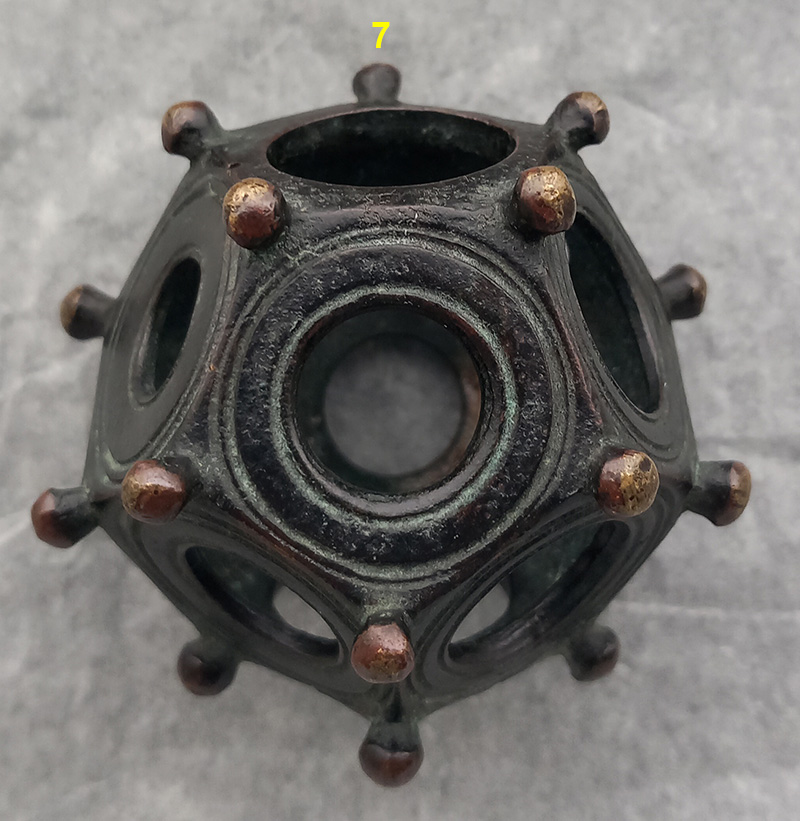

Magnified image of Face 7 hole.
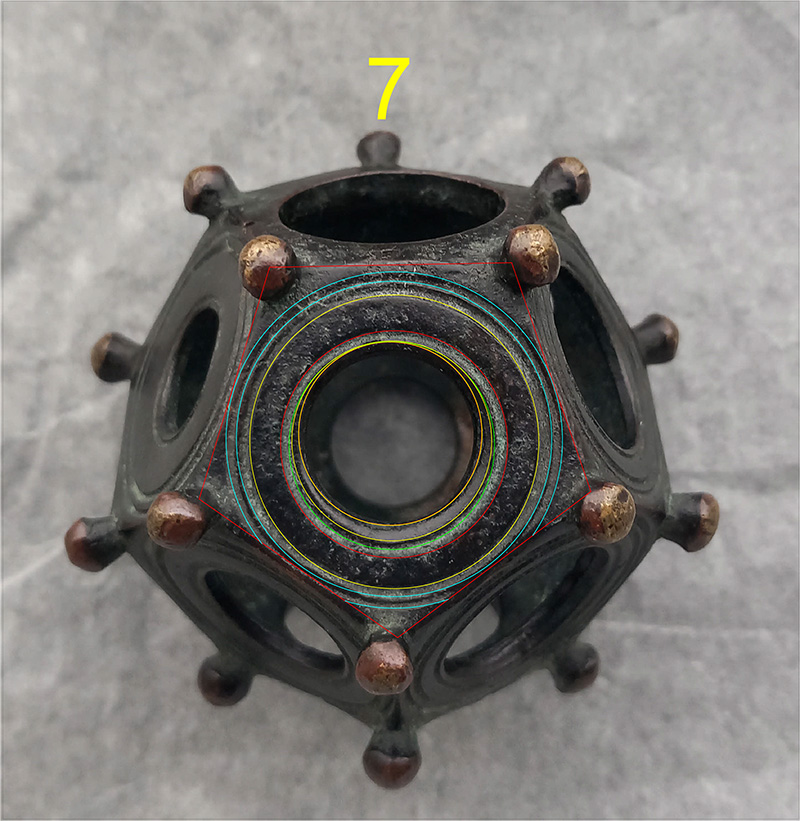
The face 7 hole was measured by Hunt Museum personnel to have a diameter of 14.3 mm, which converts to .5984252". This translates to .6" (3/5ths) to a tolerance of 1/635th of an inch longer (well beyond human vision to detect with the naked eye).
A second close-proximity number that would mnemonically be recalled in this diameter is .6048" (378/625ths), which is 156th of an inch greater than the Hunt Museum measurement, again undetectable to the eye.
The value, 6048' is navigational and represented 1-minute of equatorial arc under the navigational system encoded into the base perimeter measurement of the Great Pyramid ... two circumnavigations of which, @ 756' per side = 6048'.
FIRST OUTER CONCENTRIC RING ... YELLOW CIRCLE
(1). Once again the ancient fabricators made provision for measuring from the top edge of the hole, down to a secondary rim, slightly beyond the bottom of the hole edge. The code-bearing distance reads .6534" (3267/5000ths).This code relates to the equatorial circumference of the Earth.
A number string based upon 6.534 goes:
6.534, 13.068, 19.602, 26.136, ... 6534 ... 13068 ... 65340000 ... 130680000.
This is very simply a breakdown of the equatorial circumference of the Earth under the navigational system that used the mile of 5280. At they same time, the value .6 53184 would have simultaneously been remembered in this reading, which related to an equatorial circumference of 130636800' and a navigational system based upon the mile of 5250'.
SECOND OUTER CONCENTRIC RING ... GREEN CIRCLE
(2). This is an ellipse circle .6804 high (1701/ 2500th) and .672" wide (84/125ths). The .6804" diameter relates to the 6804-day Lunar Nutation cycle.
A number string based upon 68.04 goes:
6.804, 13.608, 20.412, 27.216, 34.02, 40.824 ... 544.32 ... 653.184 ...850.5 ... 1701 ... 3402 ... 5103 ... 6804 ... 130636800.
This is simply a number string for tracking the 6804-day Lunar Nutation cycle, but doubled as a way of reading the equatorial circumference of the Earth using Lunar Nutation cycle increments.
THIRD OUTER CONCENTRIC RING ... RED CIRCLE
(3). This circle is .7425" (297/400ths) and is a navigational string that uses the ancient Scottish mile of 5940', which was 1-furlong (660') greater than the ancient English mile of 5280'.
A number string based upon .7425 goes:
.7425, 1.485, 2.2275, 2.97, 3.7125 ... 5.94 ... 8.91 ... 11.88 ... 17.82 ... 23.76 ... 28.215 ... 31.185 ... 35.64 ... 47.52 ... 59.4 ... 65.34 ... 71.28 ...74.25 ... 891 ... 950.4 ... 1188 ... 2970 ... 5940 ... 65340000 ... 130680000.
This number string provides increments used when navigating by the 5940' Scottish mile, which was 660' (1-furlong) longer than the English mile of 5280'. The end value for the equatorial circumference of the Earth was the same under both "mile" systems of navigation ... 130680000'.
FOURTH OUTER CONCENTRIC RING ... YELLOW CIRCLE
(4). This circle is .945" (189/200ths) and generates numbers that are both navigational and lunar-cyclic.
A number string based upon .945 goes:
.945, 1.89, 2.835, 3.78, 4.725, 5.67 ... 7.56, 8.505, 9.45 ... 11.34 ... 14.175, 15.12 ... 17.01 ... 189 ... 378 ...567 ...756 ... 850.5 1512 ... 1701 ...2268 ... 3024 ...3402 ... 5103 ... 6048 ...6804 ... 362280 ... 130636800.
This string alternates between Great Pyramid base dimensions and Khafre Pyramid dimensions, as well as providing the 1/8th, 1/4th, 1/2/ 3/4ths and full duration of the Lunar Nutation cycle. In addition, all of these values are fractions of the 130680000' equatorial circumference.
Note: If the .945 value was mnemonically read as .9453125 (121/128ths), then all the increments would relate to the 130680000'equatorial circumference.
FIFTH OUTER CONCENTRIC RING ... CYAN CIRCLE
(5). This circle is 1.03125" (1 & 1/32nd) and relates to navigation using the 2nd Egyptian Royal cubit of 20.625".
A number string based upon 1.03125 goes:
1.03125, 2.0625, 3.09375, 4.125, 5.15625, 6.1875, 7.21875, 8.25, 9.28125, 10.3125 ... 16.5 ... 20.625 ... 24.75 ... 33 ... 49.5 ... 66 ... 90.75 ... 99 ... 132 ...1155 ... 5280 ... 7920 ... 76032000.
This is navigation by the 2nd or mid-range Egyptian Royal Cubit @ 20.625". There would be 3072 such cubits in an English mile of 5280' and 76032000 such cubits in the 130680000' equatorial circumference reading (24750-miles).
At the same time, this position would be mnemonically read as 1.03090909" & 1.0368" and relate to the 20.61818182" Egyptian Royal Cubit and the 20.376" Egyptian Royal Cubit, respectively.
Note: A world configured to be 130636800' (24883.2 Greek miles) would spin at a rate of 1036.8 mph in 24-hours.
Note: The Hunt Museum's dodecahedron weighs 134 grams, which equates to 4.72671 ounces or 2067.94 grains. The grain count is only 5.44 in excess of 2062.5 and the ounce count @ 437.5 grains per ounce, is only about 1/600th of an ounce different to 4.725 ounces. It seems the fabricators were trying to encode 2062.5-grains (the 20.625 ERC X 100) or 4.725 ounces into the weight of the dodecahedron ... The design height of the Khafre Pyramid was 472.5'.
SIXTH OUTER CONCENTRIC RING ... CYAN CIRCLE
(6). This circle is 1.1" (1 & 1/10th) and relates to navigation using either the ancient English mile (5280') or the ancient Scottish mile (5940') respectively.
A number string based upon 1.1 goes:
1.1, 2.2, 3.3, 4.4. 5.5, 6.6, etc., ...11... 132 ... 165 ... 176 ... 198 ... 264 ... 275 ... 297 ... 330 ... 396 ... 660 ... 5280 ... 5940 ... 7920 ... 130680000.
Again, all the increments essential to navigating by the link (7.92"), the Merchant Fathom (5.5'), the rod or perch (16.5'), the chain (66'), the furlong or furrowlong (660'), the mile (5280'), the league (16500'... 3.125-miles) or the Scottish mile (5940') are in this string (divisible by 11).
FACE 8 CIRCLE CODES
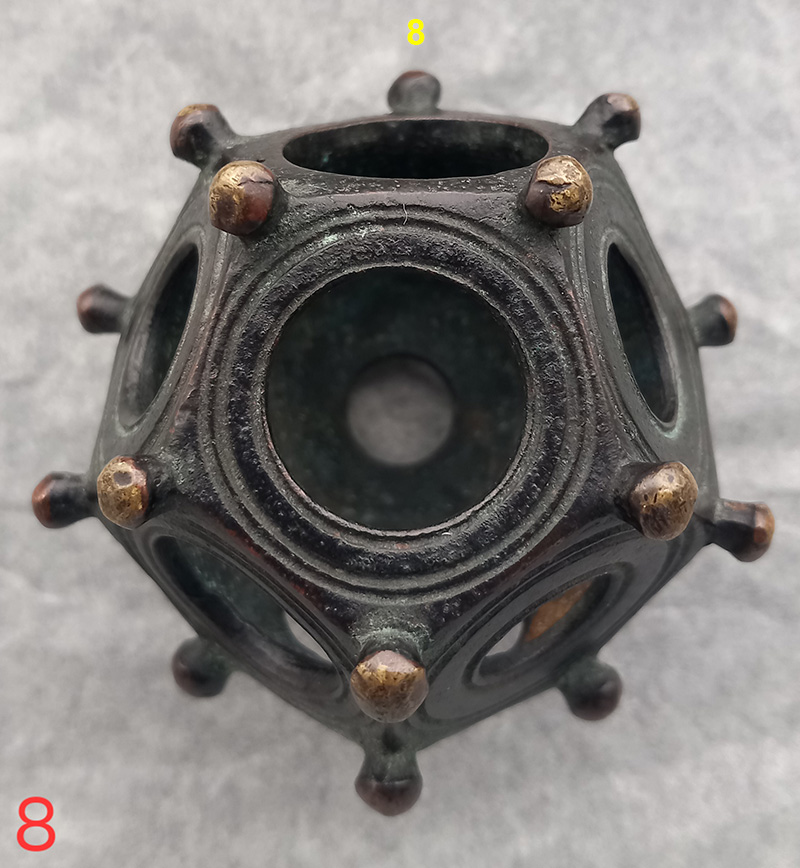
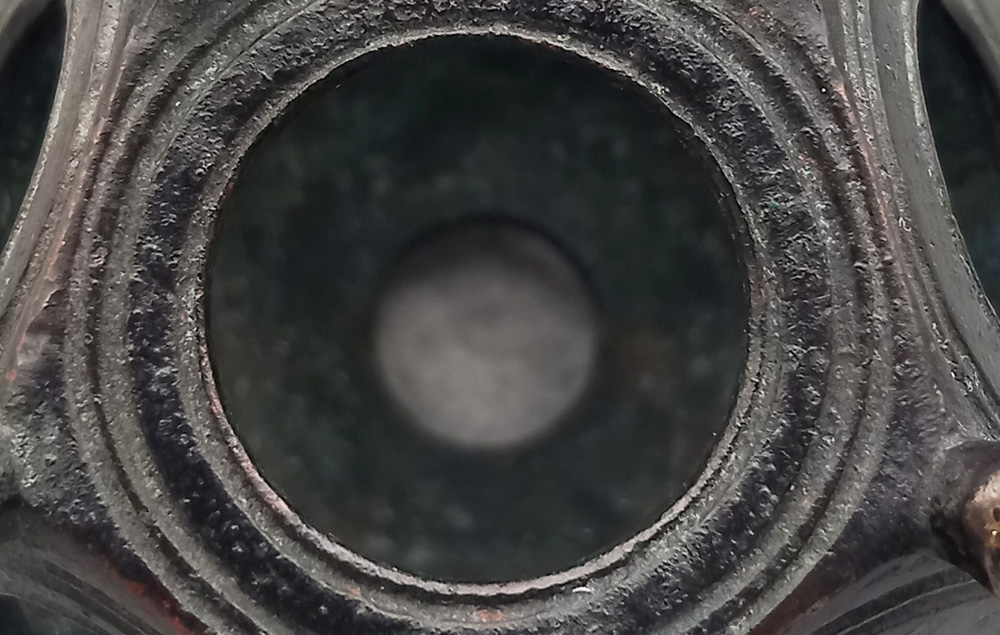
Magnified image of Face 8 hole.
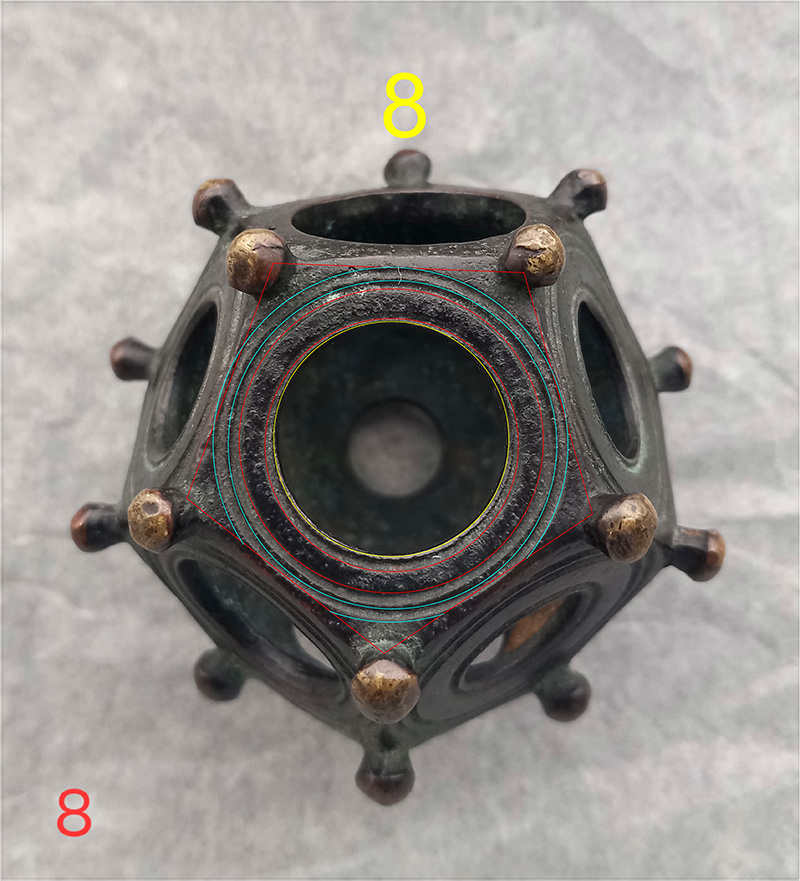
The Hunt Museum personnel measure this hole diameter to be 18.8 mm, which translates to .7401575".
The code-bearing diameter is undoubtedly .7425" or 1/427th of an inch greater ... visually undetectable. The hole circle is blended a slightly yellowed-white, indicative of the Hunt Museum measurement and .7425"combined.
A number string based upon .7425 goes:
.7425, 1.485, 2.2275, 2.97, 3.7125 ... 5.94 ... 8.91 ... 11.88 ... 17.82 ... 23.76 ... 28.215 ... 31.185 ... 35.64 ... 47.52 ... 59.4 ... 65.34 ... 71.28 ...74.25 ... 891 ... 950.4 ... 1188 ... 2970 ... 5940 ... 65340000 ... 130680000.
This number string provides increments used when navigating by the 5940' Scottish mile, which was 660' (1-furlong) longer than the English mile of 5280'. The end value for the equatorial circumference of the Earth was the same under both "mile" systems of navigation.
FIRST OUTER CONCENTRIC RING ... RED CIRCLE
(1). Again, a code-bearing diameter runs from the top rim edge of the hole to a rim edge that stands away from the bottom of the hole's edge. The diameter of the circle is .8" (4/5ths).
A number string based upon .8 goes:
..8, 1.6, 2.4, 3.2, 4, 4.8, 5.6, 6.4, 7.2, 8, 8.8, 9.6, 10.4, 11.2, 12, 12.8, 13.6, 14.4 ... 16 ... 168 ...176 ... 192 ... 200 ... 216 ... 224 ... 256 ... 264 ... 280 ... 288 ... 384 ... 432 ... 480 ... 520 ... 528 ... 576 ... 684 ... 672 ... 756 ...768 ... 776 ... 792 ... 840 ... 864 ... 1008 ... 1056 ... 1080 ... 1152 ... 1512 ... 3024 ... 5184 ... 6048 ... 6804 ... 363000 ...130680000.
This string is power packed with numbers that cover a multitude of code-bearing attributes for navigation under the 5250' mile, the dimensions and slope angle of the Great Pyramid, the Lunar Nutation Cycle, the Precession of the Equinoxes, weights & measures, including the ton & hundredweight, seconds-minutes and degrees of equatorial arc, the "pyramid acre", etc.
SECOND OUTER CONCENTRIC RING ...RED CIRCLE
(2). This circle has a diameter of .984375" (63/64ths) and, in a string progression, generates lunar cyclic numbers for the lunar month & year, as well as the 6804-day Lunar Nutation cycle
A number string based upon .984375 goes:
.984375, 1.96875, 2.953125, 3.9375 ... 5.90625 ... 7.875 ... 11.8125 ... 15.75 ... 17.71875 ... 19.6875 ... 23.625 ... 29.53125 ... 31.5 ... 354.375 ... 472.5 ... 590.625 ... 630 ... 708.75 ... 850.5 ... 945 ... 1260 ... 1417.5 ... 1701 ... 3024 ... 3402 ... 5103 ... 6048 ... 6804 ... 362880 ... 130636800.
This string contains essential lunar codes for divisions of the lunar month (29.53125-days) and .984375-days (23.625-hours) would be 1/30th of a lunar month and 1/360th of a lunar year of 354.375-days. The string also provides the 1/8th, 1/4th, 1/2, 3/4ths and full duration of the Lunar Nutation cycle. It provides values for a minute and degree of equatorial arc under the Great Pyramid's navigational system and the pertinent dimensions of the Khafre Pyramid (a pyramid of the moon). The string resolves to the equatorial circumference of the Earth encoded into the Great Pyramid's base dimensions.
THIRD OUTER CONCENTRIC RING ... CYAN CIRCLE
(3). This circle has a diameter of 1.0368" (1 & 23/625ths) and relates to the equatorial circumference of the Earth.
A number string based upon 1.0368 goes:
1.0368, 2.0736, 3.1104, 4.1472, 5.184, 6.2208, 8.2944, 9.3312, 10.368 ... 12.4416 ... 15.552 ... 18.6624... 20.736 ... 24.8832 ... 25.92 ...36.288 ... 46.656 ... 51.84 ... 62.208 ... 65.3184 ... 77.76 ... 82.944 ... 93.312 ... 129.6 ... 130.6368.
The 130636800' of the equatorial circumference of the Earth reading equates to 12 X 12 X 12 X 12 X 1.2 Greek miles of 5250' each = 24883.2 such miles. In this circumference the sum of 1555.5-miles would be 1/16th part or 22.5°; 3110.4-miles would be 1/8th or 45°; 6220.8-miles would be 1/4th or 90°; 12441.6-miles would be 1/2 and 24883.2-miles the full circumference.
The string generates both 24883.2 and 130636800.
FOURTH OUTER CONCENTRIC RING ... CYAN CIRCLE
(4). This circle has a diameter of 1.12" (1 & 3/25ths). and relates to ancient weights measures and volume standards that exist, in part, to this day.
A number string based upon 1.12 goes:
1.12, 2.24, 3.36, 4.48, 5.6, 6.72, 7.84, 8.96, 10.08, 11.2 ... 13.44 ...16.8 ... 100.8 ... 112 ... 756 ... 1400 ... 2016 ... 2240 ... 2688 ... 2800 ...3024 ... 5040 ... 5600... 6048 ... 6720 ... 8400 ... 9072 ... 362880 ... 130636800.
In traditional weights standards, a long enduring one in ancient Egypt was the "Kite, Deben & Sep" system. The basic unit appears to be a "Kite", equating to .16 British Standard ounces. One hundred "Kite" make one "Deben", equivalent to a modern era British Standard ounce and 10 Deben make one Sep, which equals 1 British Standard pound.
This led on to the latter British system of 16 "ounces" in a "pound", 14 pounds in a "stone", 112 pounds in a "hundredweight" (cwt) and 20 cwt in a "ton" ... still used in the USA today.
In 789AD, based upon expert consultation that had occurred between Charlemagne, King of the Franks and the Caliph Harun-Al-Rashid of Bagdad, Charlemagne introduced the ancient Babylonian system, based upon the Arabic gold Dinar.
The standard for a "Talent" (heavy & light) was based upon Great Pyramid dimensions, Thus:
CHARLEMAGNE HEAVY WEIGHTS. 1 Talent………907200 grains equals: |
CHARLEMAGNE LIGHT WEIGHTS. 1 Talent………453600.0 grains equals: |
The above number string, based upon a concentric circle's diameter of 1.12", incorporates coding elements of both the Kite, Deben & Sep standard of weights, as well as the values related to Great Pyramid dimensions. In the Charlemagne "heavy" Talent system, the grain weight for a Talent was 907200 grains and the length of the Great Pyramid, in inches, is 9072". The Mina weight was 15120 grains and 2 side lengths of the Great Pyramid equates to 1512'. The Shekel weight was 252 grains and the Great Pyramid side length @ 756' is 252' X 3.
In the light Talent reading, the Talent is 453600 grains and the height of the Great Pyramid to the flat-floor altar or observation platform (which has always been there) is 453.6' feet. The Mina @ 7560 grains simply encodes the length for one side of the Great Pyramid @ 756' per side. The Shekel @ 126-grains encodes the inch length of a Hebrew Reed (126" or 10 Greek feet or 5 Assyrian cubits).
FACE 9 CIRCLE CODES
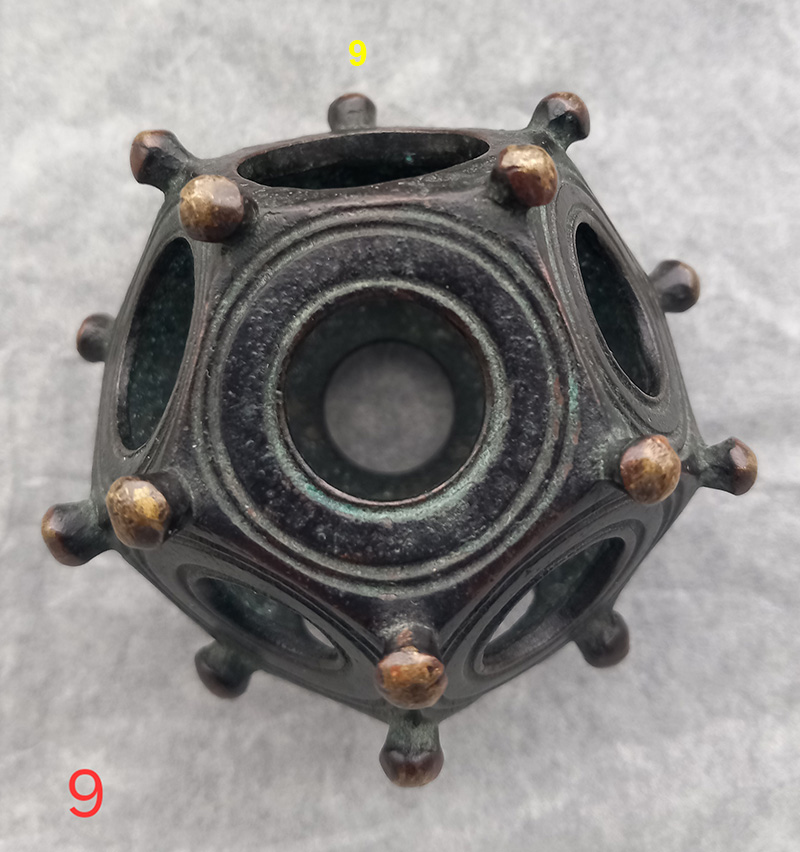
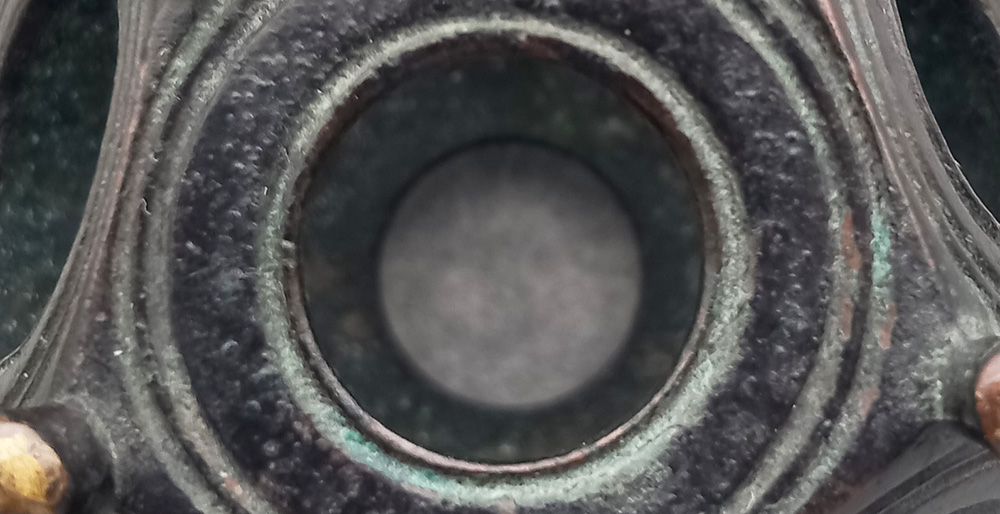
Magnified image of Face 9 hole.
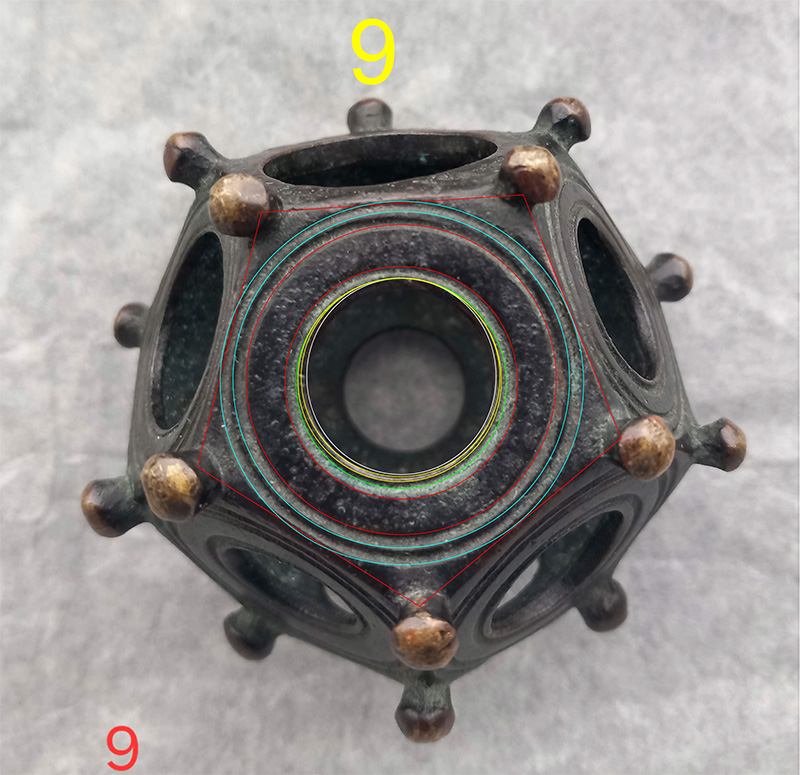
The Hunt Museum personnel measured the hole opening to have a diameter of 15.2 mm. This translates to .5629921". The intended reading of the Druid fabricators was .5625" (9/16ths), which provided a host of numbers related to navigation, the lunar cycle and the 360° system.
A number string based upon .5625 goes:
.5625, 1.125, 1.6875, 2.25, 2.8125, 3.375, 3.9375, 4.5, 5.0625, 5.625, 6.1875, 6.75 ... 7.875 ... 9 ... 10.125 ... 11.25 ... 11.8125 ... 13.5 ... 15.75 ... 18 ... 19.6875 ... 22.5 ... 24.75 ... 27 ... 31.5 ... 45 ... 90 ... 180 ... 270 ... 354.375, 360... 850.5 ... 708.75 ... 756 ... 1512 ...1701 ... 2688 ... 2835 ... 3024 ... 3402 ...6048 ...6804 ... 362880 ... 130636800.
Again, this is a dynamic string that provides the navigational numbers of the Great Pyramid, the lunar numbers of the Khafre Pyramid and the 360° system divided up in 640 parts. It also relates directly to divisions within the 6804-day Lunar Nutation cycle, combining navigational divisions with lunar cycle divisions.
FIRST OUTER CONCENTRIC RING ... YELLOW CIRCLE
(1). This circle extends from the edge or the hole top down to a half rim beyond the hole base. The distance is .590625" (189/320ths) This is lunar cycle coding and 59.0625-days would equate to 2-lunar months.
A number string, based upon .590625 goes:
.590625, 1.18125, 1.771875, 2.3625, 2.953125, 3.54375 ... 4.725 ... 5.90625 ... 7.0875 ... 9.45 ... 14.175 ... 29.53125 ... 189 ... 354.375 ... 378... 567 ... 590.625 ... 709.75 ... 756 ... 850.5 ... 1417.5 ... 1701... 2126.75 ... 2835 ... 3024 ... 3402 ... 5103 ... 6048 ... 6804 ... 362880 ... 130636800.
This string provides all of the essential divisions for the lunar month, the lunar year and the 3-4-5 triangle coding dimensions in the Khafre Pyramid. It provides all the base perimeter dimensions of the Khafre Pyramid, as well as the Great Pyramid. It generates the 1/8th, 1/4th, 1/2, 3/4ths and full duration, in days, of the Lunar Nutation cycle, as well as values for a minute, degree and full equatorial circumference of the Earth.
SECOND OUTER CONCENTRIC RING ... YELLOW CIRCLE
(2). This circle is .6048" (378/625ths) in diameter and codes 1-minute of arc in the equatorial circumference of the Earth, according to the literal navigational system encoded into the base perimeter of the Great Pyramid.
A number string based upon .6048 goes:
.6048, 1.2096, 1.8144, 2.4192, 3.024, 3.6288 ... 5.4432, 6.048 ... 9.072 ... 15.12 ... 45.36 ... 60.48 ... 65.3184 ... 756 ... 1512 ... 2268 ... 3024 ... 3402 ... 6048 ... 6804 ... 362880 ... 130636800.
This number string provides the base dimension figures for the Great Pyramid including minutes and degrees of equatorial arc, up to the full circumference, under the system that used the 5250'-mile.
Note: If the .6048 code was read as .6050, then a whole different navigation-related string would be generated, providing all the pertinent increments for the 5280' mile reading. For this the Great Pyramid's length reading would increase by 3" to 756.25" and 1-minute of arc would jump from 6048' to 6050', culminating in an equatorial circumference of 130680000'or 24750-miles of 5280'each.
THIRD OUTER CONCENTRIC RING ... GREEN CIRCLE.
(3). This circle is .625" (5/8ths) in diameter and generates navigational and 360° compass incremental values.
A number string based upon .625 goes:
.625, 1.25, 1.875, 2.5, 3.125, 3.75, 4.375, 5, 5.625, 6.25, 6.875, 7.5 ... 8.75 ... 10 ... 11.25 ... 13.125 ... 20.625 ... 22.5 ... 45 ... 50 ... 52.5 ... 55 ... 60 ... 90 ... 180 ... 270 ... 360 ... 130680000.
This number string provides essential numbers for navigation using the mile of 5280', wherein 1-degree of equatorial arc would be 69.12-miles.
Note: Under this system the equatorial circumference could be dual-read using the Egyptian Royal Cubit of 20.625" or 76032000 ERC, reducing to 211200 ERC per degree of arc.
FOURTH OUTER CONCENTRIC RING ... RED CIRCLE
(4). This circle is .6912" (432/625ths) in diameter and is navigational coding. Note: 69.12-miles would be 1° of arc in the 12 X 12 X 12 X 12 X 1.2 mile equatorial circumference (24883.2-miles).
A number string based upon .6912 goes:
.6912, 1.3824, 2.0736 ... 3.456, 4.1472 ... 6.2208 ... 6.912 ... 8.2944 ... 10.368 ... 12.4416 ... 17.28 ... 24.8832 ... 51.84 ... 69.12 ... 1555.2 ... 3110.4 ... 4665.6 ... 6220.8 ... 7776 ... 9331.2 ... 12441.6 ... 24883.2 ... 130680000.
This is yet another way of generating numbers based upon a reading of the equatorial circumference set at 24883.2-miles. Under the 3 main systems of navigation , using 3 different Egyptian Royal Cubits, the readings of the equatorial circumference of the Earth were as follows:
(1). 130636800' of 12" or 24741.81818182-miles of 5280' each or 24883.2-miles of 5250' each (12 X 12 X 12 X 12 X 1.2 Greek-miles) or 1200 X 20.61818182" Egyptian Royal Cubits = 24741.81818182 (result read as miles). This cubit is generated by 9072" (the length of the Great Pyramid in inches) ÷ 440 = 20.61818182.
(2). 130680000' of 12" or 24750-miles of 5280' each or 1200 X 20.625" (the mid-range ERC), read as miles = 24750-miles. This navigational system was based upon reading the Great Pyramid's length as 756.25' (3" longer) and considering that the base length was 9050" ÷ 440 = 20.625" X 1200 = 24750 (read as miles
(3). 131383296' of 12" or 24883.2-miles of 5280' each or 1200 X 20.736" (the biggest ERC) read as miles = 24883.2-miles. This navigational system was based upon reading the Great Pyramid's length as 760.32' (9123.84") ÷ 440 = 20.736" X 1200 (read as miles) = 24883.2- miles of 5280'each.
Although it doesn't appear that this equatorial value was used in navigation, the ancient savants needed an easily divisible or factorable value to describe the TRUE size of the Earth's equatorial circumference. They therefore set that figure at the easily remembered formula of 12 X 12 X 12 X 12 X1.2 miles of 5280' each, which was only 18.8-miles less than the true circumference of 24902-miles.
The formula for finding the elongated base length of the Great Pyramid, which would relate to the TRUE equatorial circumference, is:
24883.2- miles ÷ 360° = 69.12 X 5280 = 364953.6' ÷ 480 = 760.32' or 440 X 20.736".
FIFTH OUTER CONCENTRIC RING ... RED CIRCLE
(5). This circle is .9216" (576/625ths) in diameter and is navigational coding.
A number string based upon .9216 goes:
.9216, 1.8432, 2.7648, 3.6864, .4608 ... 8.2944, 9.216, 10.1376 ... 13.824 ... 11.52 ... 23.04 ... 24.883.2 ... 41.472 ... 46. 08 ... 57.6 ...69.12 ...80.64 ... 92.16 ... 103.68 ... 115.2 ... 124.416 ... 126.72... 138.24 ... 149.76 ... 161.28 ... 172.8 ... 184.32 ... 195.84 ... 207.36 ...218.88 ... 241.92 ... 230.4 ... 253.44 ... 276.48 ... 264.96 ... 288 ... 311.04... 345.6 ..., etc, ... 12441.6 ... 24883.2.
This is method for reading the 24883.2-mile circumference in increments of 11.52-miles or 1/ 2160th part or 600 divisions.
Under the TRUE ancient reading for the equatorial circumference of the Earth @ 12 X 12 X 12 X 12 X 1.2-miles of 5280' each (131383296') the sum of 1-second of equatorial circumference arc for the Earth equated to 101.376'; 1-minute of arc was 6082,56'; 1-degree of arc was 364953.6' and 360° was 131383296'.
SIXTH OUTER CONCENTRIC RING ... CYAN CIRCLE
(6). This circle is 1" in diameter.
So, once again the Druidic owner/ reader of this memory device had precise reference to 1" and with calipers could create accurate, calibrated measurement rules.
SEVETH OUTER CONCENTRIC RING ... CYAN CIRCLE
(7). This circle is 1.08" (1 & 2/25ths) in diameter.
A number string based upon 1.08 goes:
1.08, 2.16, 3.24, 4.32, 5.4, 6.48, 7.56, 8.64, 9.72, 10.8, 11.88, 12.96, 14.04, 15.12, 16.2, 17.28 ... 27 ... 51.84 ...69.12 ... 378 ... 756 ... 1036.8 ... 1134 ... 1166.4 ... 1512 ... 1944 ... 2268 ... 2592 ... 2916 ... 3024 ... 3402 ... 3456 ... 3888 ... 4536 ... 5832 ... 5940 ... 6048 ... 6804 ... 7776 ... 9072 ... 9720 ... 362880 ... 130636800
This number string provides navigational numbers, based upon the dimensions & angle encoded into the Great Pyramid's base measurement & face-slope angle. This is a multi-purpose string, which can be applied to a wide range of calculations, including the Precession of the Equinoxes, the Lunar Nutation cycle, weights measures & volume standards, etc.

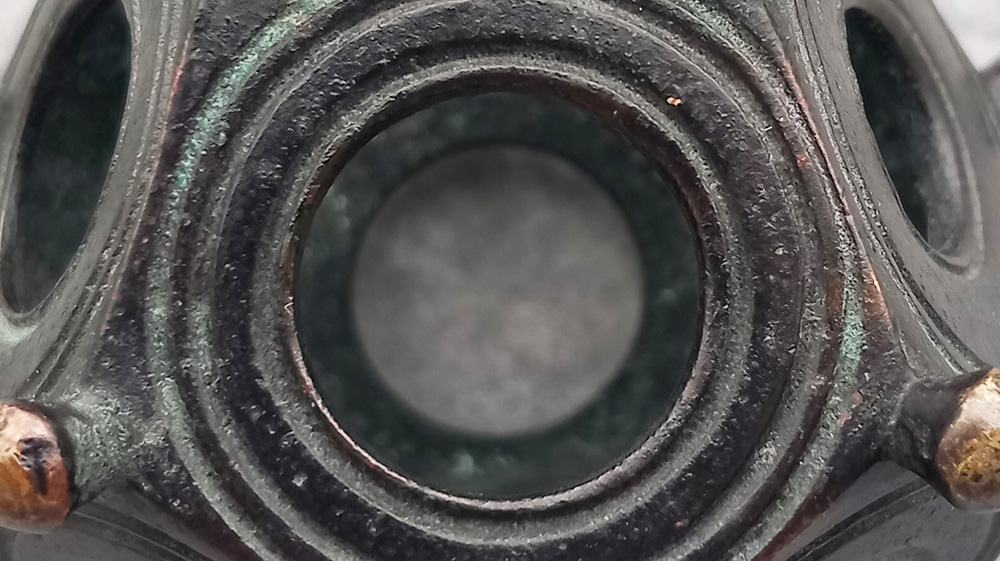
Magnified image of Face 10 hole.
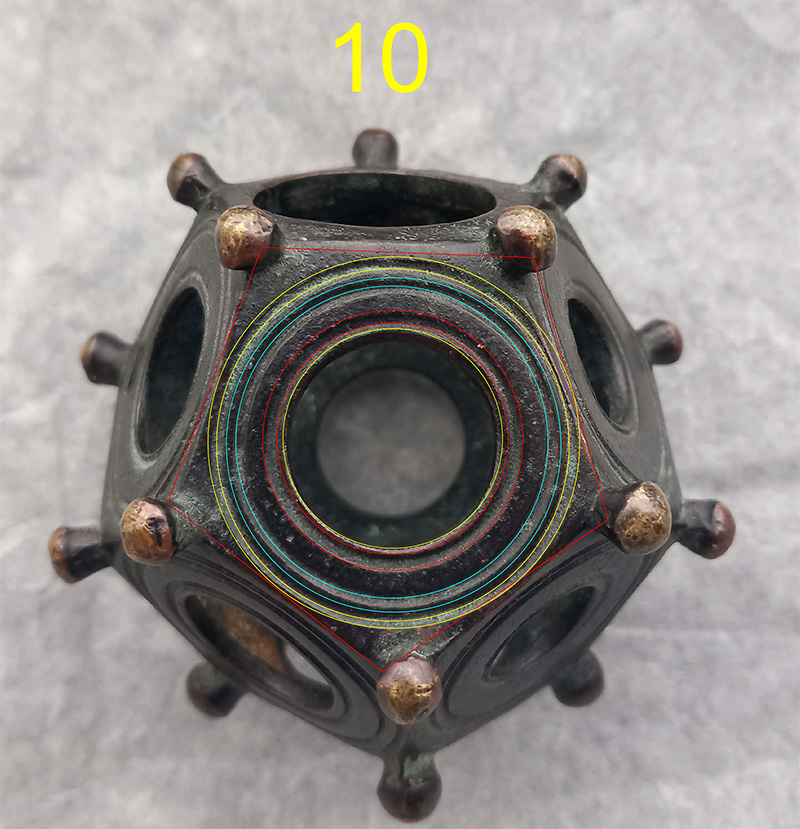
The Hunt Museum personnel measured this face-hole to be 16.2 mm, which translates to .6377953". The Druid fabricator's intent was .64" (1/454th of an inch greater), but with mnemonic recall to .63"
A number string based upon .64 goes:
.64, 1.28, 1.92, 2.56, 3.2, 3.84, 4.48, 5.12, 5.76, 6.4, 7.04, 7.68 ... 9.6, 10.24 ... 11.52 ... 16 ... 128 ... 192 ... 756 ... 1134 ... 1152 ...1536 ... 1728 ... 2304 ... 2688 ... 3024 ... 4608 ... 6048 ... 362880 ... 130636800.
It can be readily seen that one can use this string for 1/320th divisions within a 360° circle. One can divide up the equatorial circumference of the Earth, the Lunar Nutation cycle, the 360° compass etc., into convenient and easy to manipulate bite-size lumps.
A number string based upon .63 goes:
.63, 1.26, 1.89, 2.52, 3.15, 3.78 ... 5.04. 5.67, 6.3 ... 7.56 ... 9.45 ... 10.08 ... 11.34 ... 12.6 ... 25.2 ... 100.8 ... 378 ... 453.6 ... 472.5 ... 567 ... 850.5 ... 1134 ... 1512, 1575... 1306.8 ... 1701 ... 2016 ... 2268 ... 2835 ... 3024 ... 3402 ... 4032 ... 5103 ... 6048 ... 6300 ... 6804 ... 9072 ... 12096 ... 14175 ... 362880 ... 130636800.
This string provides the essential Great Pyramid numbers for navigation around the Earth. It also provides the 1/8th, 1/4th, 1/2, 3/4ths and full duration, in days, of the Lunar Nutation cycle.
Note: The Druidic Calendar of Coligny bronze plaque (a lunisolar calendar) found in France in 1897 is set out in 128 squares, with provision for counts in 64 or 63 (Ciallos intercalary options). Using the Pyramid value 1890 ÷ 63 = 30 ... the solar month duration was described as 30-days). However, 1890 ÷ 64 = 29.53125-days (29 & 17/32nds) this described the lunar month duration, accurate to under 1-minute in time.
FIRST OUTER CONCENTRIC RING ... RED CIRCLE
(1). This circle is .672" (84/125ths) which is navigational coding. Note: the ancient Irish mile was 6720'.
A number string based upon .672 goes:
.672, 1.344, 2.016, 2.688, 3.36, 4.032, 4.704, 5.376, 6.048, 6.72 ... 8.064 ... 10.08 ... 12.096 ... 16.8 ... 50.4 ... 36.288 ... 2016 ... 2688 ... 3024 ... 5376 ... 5443.2 ... 6048 ... 6804 ... 362880 ... 130636800.
Again, this string provides numbers for navigation based upon Great Pyramid measurements.
SECOND OUTER CONCENTRIC RING ... RED CIRCLE
(2). This circle is .756" (189/250ths) which is navigational and based upon the perimeter lengths of the Great Pyramids, one side length of which is 756' or 1/8th of 1-minute of equatorial arc in the Earth's circumference.
A number string based upon .756 goes:
.756, 1.152, 2.268, 3.024 3.78, 4.536 ... 6.048, 6.804, 7.56 ... 9.072 ... 11.34, 12.096, 13.608 ... 189 ... 378 ... 567 ... 756 ... 1512 ... 2268 ... 3024 ... 6048 ... 362880 ... 130636800.
This is a very direct number sequence that homes in on the great Pyramid navigational method all the way up to the equatorial circumference of the Earth @ 12 X 12 X 12 X 12 X 1.2 Greek miles of 5250' each (24883.2-miles).
THIRD OUTER CONCENTRIC RING ... CYAN CIRCLE
Once again, a concentric ring that accentuates Great Pyramid numbers, this time the length of one side in inches (9072").
A number string based upon .9072 goes:
.9072, 1.8144, 2.7216, 3.6288, 4.536, 5.4432 ... 9.072 ... 13.608 ... 22.68 ... 6531.84 ... 6804 ...362880 ... 130636800.
This beginning value could also have been .9075, and relate to the 2nd navigational method using the mile of 5280'. A number string based upon .9075 goes:
.9075, 1.815, 2.7225, 3.63, 4.5375, 5445 ... 9.075 ... 13.6125 ... 22.6875 ... 65.34 ... 363000 ... 130680000.
The circle diameter .9072" is 567/625ths. The circle diameter .9075 is 363/400ths.
FOURTH OUTER CONCENTRIC RING ... CYAN CIRCLE.
(4). This diameter is .9720" (243/250ths) and relates to navigation, the equatorial circumference of the Earth, the lunisolar Sabbatical Calendar method and the 6804-day lunar nutation cycle.
A number string based upon .9720 goes:
.9720, 1.944, 2.916, 3.888, 4.86, 5.832, 6.804, 7.776 ... 9.72 ... 11.664 ... 13.608 ... 14.58 ... 15.552 ... 19.44 ... 23.328 ... 24.3 ... 729 ... 1215 ... 3110.4 ... 3402 ... 4665.6 ... 4860 ... 5443.2 ... 6804 ... 7290 ... 93312 ... 12441.6 ... 24883.2 ... 130636800 ... 13122000.
This number string introduces another very ancient system of navigation, which was adopted by the late emerging Roman civilisations. Like the Greeks, the Romans used older metrology systems handed down to them from much earlier civilisations.
The above string includes 11.664" (the Roman foot), 58.32" (the Roman Pace ... 5 Roman feet), 23.328" (the Swedish Rydaholmsalm ... 2 Roman feet), 4860' ( the Roman mile) and reference to 7.29".(1/8th of a Roman Pace)
These are measurement increments that were used by the Romans and the ancient Swedes.
The Roman foot was found to be 11.664 inches by John Greaves, professor of geometry, who in 1639 went to Rome specifically to ascertain the length of an ancient Roman foot. Greaves located a monument of Roman architect, Stalius Asper and measured bas-relief instruments used by him in the first century A. D. Greaves concluded, after careful investigation, that the Roman foot, 'contained 1944 such parts as the English foot contains 2000'. This means a Roman foot of 11.664 inches. See: https://en.wikipedia.org/wiki/John_ Greaves
Well yes, it was certainly 11.664” in mathematical progressions tracking lunar cycles or volume capacities, etc., but the simpler value of 11.66666” (11 & 2/3rds) was, without doubt, used for overland distances, with a Pace of 58.333333” (5 Roman feet). The same foot, in doubled values, was used in Sweden for the Rydaholmsalm length (1.94444’ or 23.3333").
We know that the Romans had an overland marching foot of 11.66666”and a pace of 58.333333” or 5 Roman feet, as, trying to stay abreast of distances covered by a cumbersome foot of 11.664" or Pace of 58.32", would be a nightmare. For overland marching the simple foot of 11.66666" (11 & 2/3rds) would be pressed into service, whereas the 11.664 increment was absolutely invaluable in weights & volumes systems.
We also can see that the ancient Swedes had a slightly altered Rydaholmsalm of 1.944444’or 23.333333” (2 Roman overland marching feet).
We know that the Swedes had a Mil of 6000 Famm (fathoms), 18000 Aln (ells) = 35000 feet of 12-inches. This distance would also be 36000 Roman feet of 11.666666".
One of the more ancient concepts that survived into Mediaeval times was that 75-Roman miles was 1-degree of arc in the equatorial circumference of the Earth.
If we considered those feet to be 11.664", then the Roman mile would equate to 4860' of 12"... or 5000 Roman feet ... X 75 = 364500' X 360 = 131220000' of 12" each.
If we consider those feet to be 11.666666" (about 1/400th of an inch greater than 11.664") then the Roman mile becomes 4861.111111' of 12" or 5000 Roman feet ... X 75 = 364583.3333333 X 360 = 13125000' of 12 " each.
The sum of 131250000 feet of 12" would equate to: 125000000 Greek feet or 135000000 Roman feet or 67500000 Swedish Rydaholmsalm or 27000 Roman miles or 3750 Swedish Mil or 25000 Greek miles.
In order to encode the 1/400th of an inch longer Roman foot measurement, the above number string (.972") would increase to .97222222.
Note: The Greek liquid volume called the Metretes was 2332.8 cubic inches, using the same value as the Swedish Rydaholmsalm X 100.
The second reading of the .972 value, slightly enlarged for overland distance calculations goes:
.9722222, 1.944444, 2.916666, 3.88888, 4.861111, 5.833333, 6.8055555, 7.77777, 8.75, 9.722222 ... 11.66666 ... 17.5 ... 23.33333 ... 4861.11111 ... 364583.33333 ... 131250000.
FIFTH OUTER CONCENTRIC RING ... YELLOW CIRCLE
(5). This diameter is 1.024" (1 & 3/125ths) and relates to the equatorial circumference of the Earth, also 64th divisions of the 24883.2-mile circumference.
This string subdivides the 24883.2-mile (of 5280') TRUE equatorial circumference down in 1024, 512, 256, 128, 64, 32, 16, 8, 4 & 2 parts. It will also work for the 24883.2-mile of 5250' reading.
Therefore:
24883.2 X 5280' = 131383296' ÷ 1024 = 128304' = 24.3-miles ... X 2 = 48.6; ... X 2 = 97.2; ... X 2 = 194.4; ... X 2 = 388.8; ... X 2 = 777.6; ... X 2 = 1555.2; ... X 2 = 3110.4; ... X 2 = 6220.8; ... X 2 = 12441.6; ... X 2 = 24883.2.
So, 24.3-miles is 1/1024th; 48.6-miles is 1/512nd; 97.2-miles is 1/256th; 194,4-miles is 1/128th; 388.8-miles is 1/64th; 777.6-miles is 1/32nd; 1555.2-miles is 1/16th; 3110.4-miles is 1/8th; 6220.8-miles is 1/4th; 12441.6-miles is 1/2.
There are many very useful numbers generated in the number string, but the above explanation best describes its overall function.
SIXTH OUTER CONCENTRIC RING ... YELLOW CIRCLE
(6). This diameter is 1.08" (1 & 2/25ths) and relates to navigation, the Precession of the Equinoxes and is a mult-use number.
A number string based upon 1.08 goes:
1.08, 2.16, 3.24, 4.32, 5.4, 6.48, 7.56, 8.64, 9.72, 10.8, 11.88, 12.96, 14.04, 15.12, 16.2, 17.28 ... 27 ... 51.84 ...69.12 ... 378 ... 756 ... 1036.8 ... 1134 ... 1166.4 ... 1512 ... 1944 ... 2268 ... 2592 ... 2916 ... 3024 ... 3402 ... 3456 ... 3888 ... 4536 ... 5832 ... 5940 ... 6048 ... 6804 ... 7776 ... 9072 ... 9720 ... 362880 ... 130636800
This number string provides navigational numbers, based upon the dimensions & angle encoded into the Great Pyramid's base measurement & face-slope angle. This is a multi-purpose string, which can be applied to a wide range of calculations, including the Precession of the Equinoxes, the Lunar Nutation cycle, weights, measures & volume standards, etc.
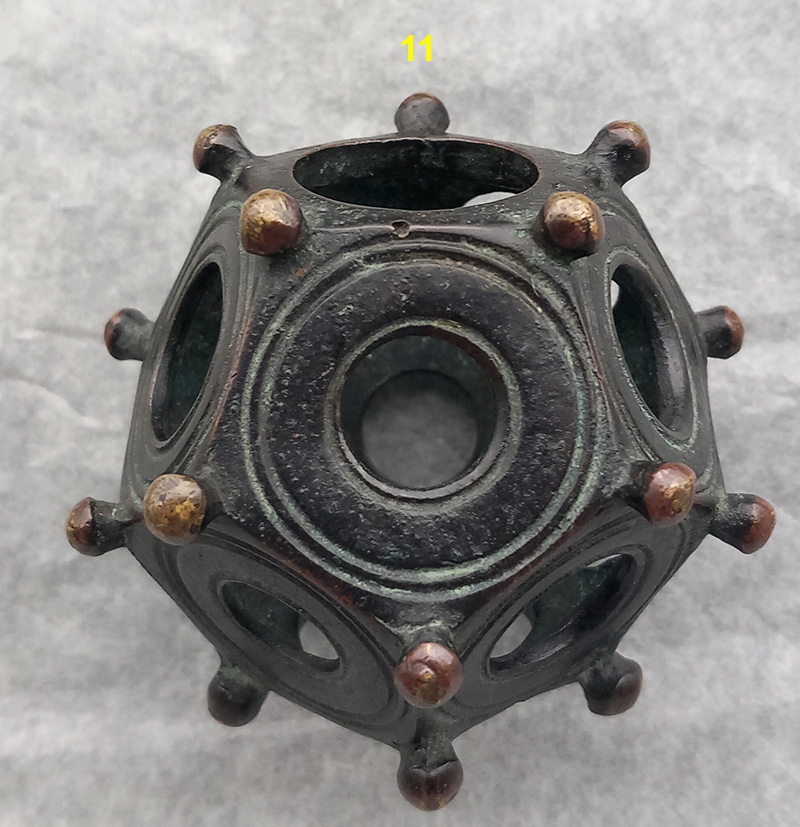
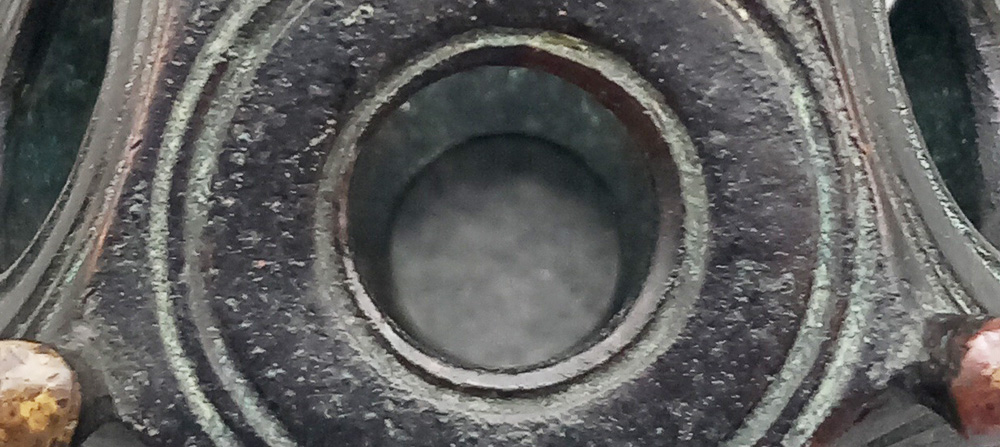
Magnified image of Face 11 hole.
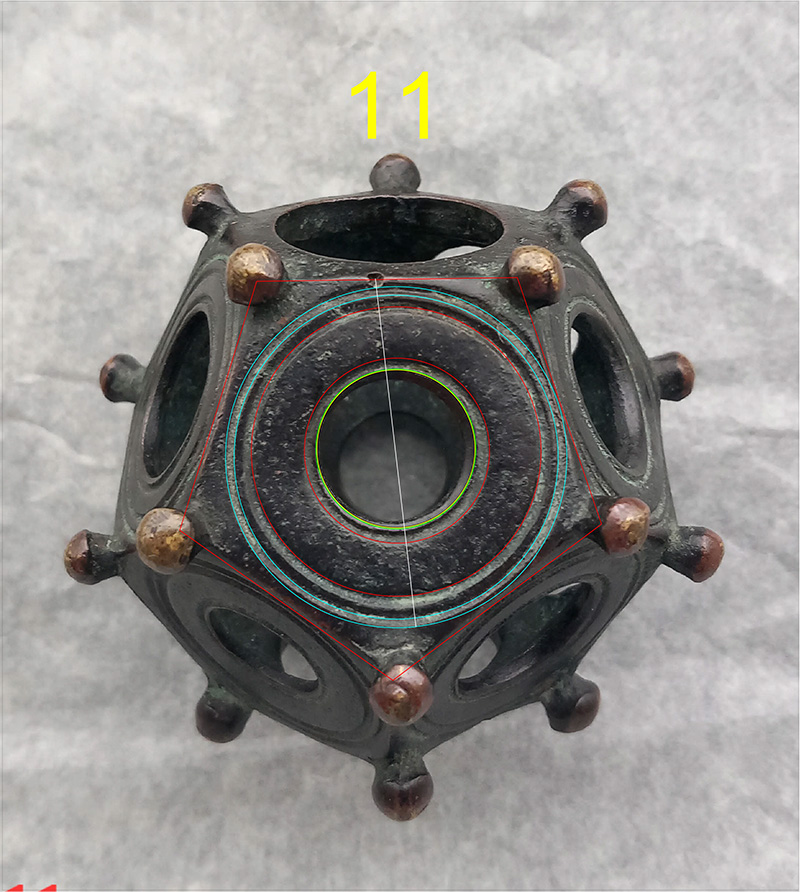
The Hunt Museum personnel measured the diameter of this face-hole to be 12.1 mm, which translates to .476378", which would have been either .4752", .48" or .486" respectively.
FIRST OUTER CONCENTRIC RING ... RED CIRCLE
(1). This circle diameter is .5625" (9/16ths) and relates to a progression-string for the 360° compass, lunar cycle calculations and navigation.
A number string based upon .5625 goes:
.5625, 1.125, 1.6875, 2.25, 2.1825, 3.375, 3.9375, 4.5, 5.0625, 5.625, 6.1875, 6.75 ... 7.875 ... 9 ... 10.125 ... 11.25, 11.8125, 12.375 ... 13.5 ... 15.75 ... 18 ... 19.6875 ... 22.5 ... 24.75 ... .90 ... 180 ... 270 ... 315 ... 354.375 ... 360 ... 472.5 ... 495 ... 540 ... 590.625 ... 630 ... 708.75 ... 720 ... 990 ... 1080 ... 1215 ... 1260 ... 2835 ... 248832 ... 130636800.
For a Druidic astronomer-navigator, this is a power-packed string, which divulges a huge amount of information. It provides the values for reading the 360° compass, segmented down into 32nd, 16th, 8th, 4ths, 1/2. 3/4ths parts and the full circuit. It indentifies the 3,4,5 triangle codes of the Khafre Pyramid of Egypt (a pyramid of the moon) as half the base length = 354.375' ... 3 X 118.125-days (12 lunar months of 29.53125-days ... 29 & 17/32nds); the pyramid's height = 472.5' ...4 X 118.125-days (16 lunar months); The sloping faces of 590.625' ... 5 X 118.125 (20 lunar months). It then goes on to divulge the length of the Khafre Pyramid, as well as the whole perimeter value.
Within a full readout of the string are all the numbers relevant to the very important Lunar Nutation cycle (i.e.) 850.5-days (1/8th); 1701-days (1/4th); 3402-days (1/2); 5103-days (3/4ths); 6804-days (the full duration).
The string goes on to give the numbers relevant to divisions within the equatorial size of the Earth.
.SECOND OUTER CONCENTRIC RING ... RED CIRCLE
(2). This circle diameter is .88" (22/25ths) and navigation by the 5280'mile.
A number string, based upon 88 goes:
88, 176, 264, 352, 440, 528, 616, 704, 792, 880 ... 1056 ... 1320 ... 1584 ... 1760 ... 2112, 2200... 2376 ... 2640 ... 3168 ... 3960 ... 4752 ... 5280 ... 6336 ... 6600 ... 7128 ... 7920 ... 11000 ... 33000 ... 59400 ... 130680000.
This string is navigational under the system that used the English mile of 5280' (or Scottish mile of 5940'); the league of 16500'; the diameter of the Earth set @ 7920-miles or the full equatorial circumference @ 130680000' (24750-miles).
THIRD OUTER CONCENTRIC RING ... CYAN CIRCLE
(3). This circle diameter is .984375" (63/64ths) and relates to lunar calculations, beqa gold dust standard weight and navigation by the 5250'mile.
A number string based upon .984375 goes:
.984375, 1.96875, 2.953125, 3.9375 ... 5.90625 ... 7.875 ... 11.8125 ... 15.75 ... 17.71875 ... 19.6875 ... 23.625 ... 29.53125 ... 31.5 ... 354.375 ... 472.5 ... 590.625 ... 630 ... 708.75 ... 850.5 ... 945 ... 1260 ... 1417.5 ... 1701 ... 3024 ... 3402 ... 5103 ... 6048 ... 6804 ... 362880 ... 130636800.
This string contains essential lunar codes for divisions of the lunar month (29.53125-days) and .984375-days (23.625-hours) would be 1/30th of a lunar month and 1/360th of a lunar year of 354.375-days. The string also provides the 1/8th, 1/4th, 1/2, 3/4ths and full duration of the Lunar Nutation cycle. It provides values for a minute and degree of equatorial arc under the Great Pyramid's navigational system and the pertinent dimensions of the Khafre Pyramid (a pyramid of the moon). The string resolves to the equatorial circumference of the Earth encoded into the Great Pyramid's base dimensions.
FOURTH OUTER CONCENTRIC RING ... CYAN CIRCLE
(4). This circle is 1.0368" (1 & 23/625ths) and relates to the equatorial circumference of the Earth and how fast the Earth rotates in miles per hour.
A number string based upon 1.0368 goes:
1.0368, 2.0736, 3.1104, 4.1472, 5.184, 6.2208, 8.2944, 9.3312, 10.368 ... 12.4416 ... 15.552 ... 18.6624... 20.736 ... 24.8832 ... 25.92 ...36.288 ... 46.656 ... 51.84 ... 62.208 ... 65.3184 ... 77.76 ... 82.944 ... 93.312 ... 129.6 ... 130.6368.
The 130636800' of the equatorial circumference of the Earth reading equates to 12 X 12 X 12 X 12 X 1.2 Greek miles of 5250' each = 24883.2 such miles. In this circumference the sum of 1555.5-miles would be 1/16th part or 22.5°; 3110.4-miles would be 1/8th or 45°; 6220.8-miles would be 1/4th or 90°; 12441.6-miles would be 1/2 and 24883.2-miles the full circumference.
The string generates both 24883.2 and 130636800.
DIAGONAL WHITE VECTOR
(5). The white line extending from the bored recess at the top of face 11 to the last concentric circle at the bottom extremity is 1.0666666" (1 & 333/500ths). Note: @ 10.66666" this became the long enduring Pied du Roi of France.
A number string of 1.066666"goes:
1.066666, 2.133333, 32, 4.266666, 5.33333, 6.4, 7.466666, 8.533333, 9.6, 10.66666 ... 12.8 ... 16 ... 19.2 ... 22.4 ... 112 ... 256 ... 288 ... 320 ... 352 ... 384 ... 480 ... 512 ... 576 ... 640 ... 672 ... 704 ... 768 ... 800 ... 864 ... 1024 ... 1056 ... 1152 ... 1280 ... 1344 ... 1440 ... 1536 ... 1728 ... 1760 ... 2016 ... 2112 ... 2240 ... 2304 ... 2560 ... 2592 ... 2688 ... 3360 ... 5120 ... 5280 ... 130636800 & also 130680000.
Note: the value 10.6666666 X 2332.8 = 24883.2, indicating a significant link between the Pied du Roi of France and the Rydaholmsalm of Sweden, as well as the Roman foot. A Pied du Roi @ 10.66666" X a Roman foot @ 11.664" = 124.416 ... or a reduced number applicable half the equatorial size of the Earth in miles.
The Pied du Roi is dynamic and will provide both Great Pyramid values and Khafre Pyramid numbers simultaneously. For example, the side values: 756 ÷ 1.0666666 = 708.75; or the perimeter values: 3024 ÷ 1.0666666 = 2835.
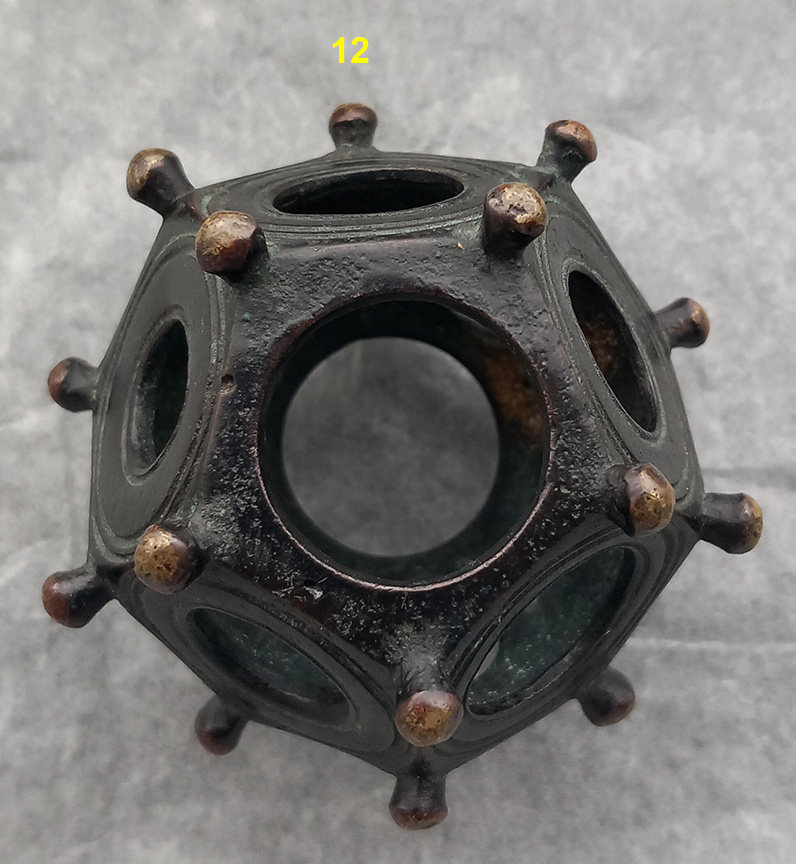
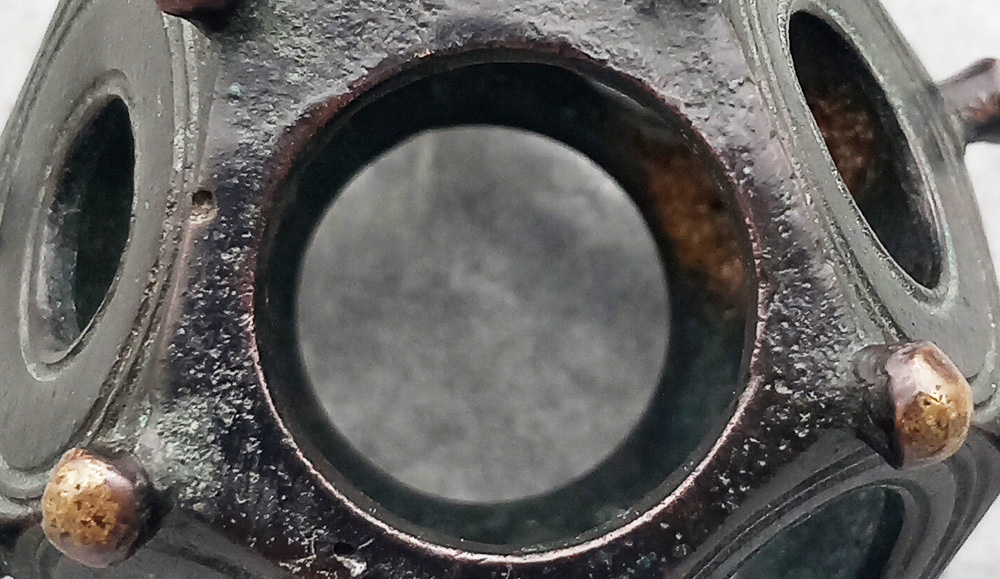
Magnified image of Face 12 hole.

The Hunt Museum personnel measured this hole to a diameter of 21.8 mm, which translates to .8582677". The sought after coded number was .864" (108/125ths) or only 175th of an inch greater.
A number string based upon 864 goes:
.864, 1.728, 2.592, 3.456, 4.32, 5.184, 6.048, 6.912, 7.776, 8.64, 9.504, 10.368 ... 12.096, 12.96, 13.824... 15.552 ... 19.008 ... 20.736, 21.6 ... 23.328, 25.92 ... 28.512 ... 3024 ... 6048 ... 362880 ... 24883.2 ... 130636800.
This, again relates to navigation under The Great Pyramid's encoded measurements; It provides values for the Precession of the Equinoxes duration; It tells us how fast the Earth rotates in 24-hours; It identifies the Swedish length of their ancient Rydaholmsalm, as well as the length of the largest Egyptian Royal Cubit, etc.
THE CROSSING LINES
The crossing line running downwards to the right from a bored indent has a length of .96" (24/25ths). The line running from the bottom bored indent has a length of .93312" (2916/ 3125ths) and relates to navigation by the 5250'-mile.
Note: the ancient Babylonian-Sumerian Talent was 933120 grains weight.
A number string based upon 96 goes:
96, 192, 288, 384, 480, 576, 672, 768, 864, 960, 1056, 1152 ... 1344, 1440, 1536 ... 1728 ... 1920, 2016, 2112 ... 2304 ... 2592, 2688 ... 3456 ... 5184, 5280 ... 6048 ... 6720 ... 6912 ... 7776 ... 9072 ... 9504 ... 10080 ... 10368 ... 13824 ... 19008 ... 20736 ... 21600 ... 25920 ... 362880 ... 248832 ...130636800.
By using this string, based upon increases of the number 96, the Druidic savant could complete counts of miles in the equatorial circumference of the Earth, based upon the mile of 5250 feet (of 12-inches each ... which became known as the Greek mile by the golden age of the Greek empire ... 500 BCE).
There would be 2160 X 11.52-miles in the equatorial circumference; 777.6-miles would be 1/32nd of the circumference or 11.25° of arc; 69.12-miles would be 1° of arc.
The Druidic savant could also calculate seconds, minutes and degrees of arc, based upon 1-second being 100.8-feet of 12-inches each, 1-minute of arc being 6048-feet, 1° of arc being 362880-feet and the full circumference being 362880' X 360 = 130636800-feet or 12 X 12 X 12 X 12 X 1.2 Greek miles of 5250-feet of 12" (which equates to 5000 Greek feet of 12.6" each ... or 24883.2 miles 0f 5250').
With this string the Druidic savant could also calculate intervals of time within the 25920-year-long cycle of the Precession of the Equinoxes, with 2592-years being 1/10th of the cycle and 5184-years being 1/5th.
There would be 270 X 96-years in the cycle of Precession, with 1° of shift occurring over each 72-years, requiring 1-day of adjustment needed every 72-years to keep the day of the equinox true to the calendar count.
In this 25920-year count, the sun spends 2160-years in each of the 12 Houses of the Zodiac.
.A number string based upon .93312 goes :
.93312, 1.86624, 2.79936 ... 4.6656 ... 6.53184 ... 9.3312 ... 13.06368 ... 23.328 ... 46656 ... 6531.84 ... 93312 ... 116640 ... 130636800.
ROYAL DOUBLE STANDARD.
1 Talent………933120 grains, equals: |
ROYAL SINGLE STANDARD.
1 Talent……… 466560 grains, equals: |
This ancient Babylonian-Sumerian heavy standard was for payments to the royal treasury and some weights of this type bear the inscription, "of the King" ... double-dipping ... the divine right of kings ... sounds about right!.
GAINING AN UNDERSTANDING OF THE ANCIENT MATHEMATICAL CODES
The 133 or so dodecahedral found so far, offer a unique opportunity for the worldwide research community to gain a comprehensive understanding of the ancient mathematical codes that needed to be remembered at all cost, if the concept of CIVILISATION was to be preserved.
This researcher is very grateful for the Hunt Museum, Limerick, Ireland personnel for taking the time to provide excellent research materials related to the dodecahedron in their collection.
However, not all the repositories of these wonderful objects are so generous and forthcoming with the research information, choosing instead to refuse release of any definitive measurements that could lead to deciphering the encoded information within dodecahedra.
For the most part, the mainstream attitude appears to be that dodecahedron artifacts pose some kind of eternally unsolvable mystery and shall so remain forever. It's also the conclusion of many learned-experts that our remote-epoch ancestors had only the most rudimentary knowledge of measurements, astronomical cycles, lunisolar calendar systems or positional-plotting mathematics for navigation , etc.
Nothing could be further from the truth!
A very good example of a draconian and somewhat arrogant attitude of censorship being imposed relates to the Norton Disney dodecahedron unearthed in June 2023. An official commentator, claiming intellectual-property rights for the object states, 'We maintain control of it so it doesn't get out of hand'.
Apart from a few miserly photos appearing in Internet magazine articles, there's been no useful release of precise measurements, despite many requests from around the world.
So, someone, many centuries ago and possibly up to two millennia, fabricated an object that is now, arrogantly, considered to be personal intellectual property! ... only for very limited publc disclosure and scrutiny.
This researcher has made repeated requests for proper research materials, sufficient for deciphering the measurement attributes of the Norton Disney artifact, to no avail, as the requests fall upon deaf ears.
Martin Doutré, June 3rd, 2025 ©.